Organizational Leadership Styles and Cultures
VerifiedAdded on 2020/01/07
|24
|6614
|366
Essay
AI Summary
This assignment delves into the diverse world of organizational leadership styles and cultures. It examines different approaches to leadership, including strategic management, transactional, transformational, and situational leadership. Furthermore, it analyzes the influence of cultural dimensions like individualism, masculinity, and uncertainty avoidance on workplace dynamics. Students are expected to critically evaluate these concepts and their practical implications in shaping organizational effectiveness.
Contribute Materials
Your contribution can guide someone’s learning journey. Share your
documents today.
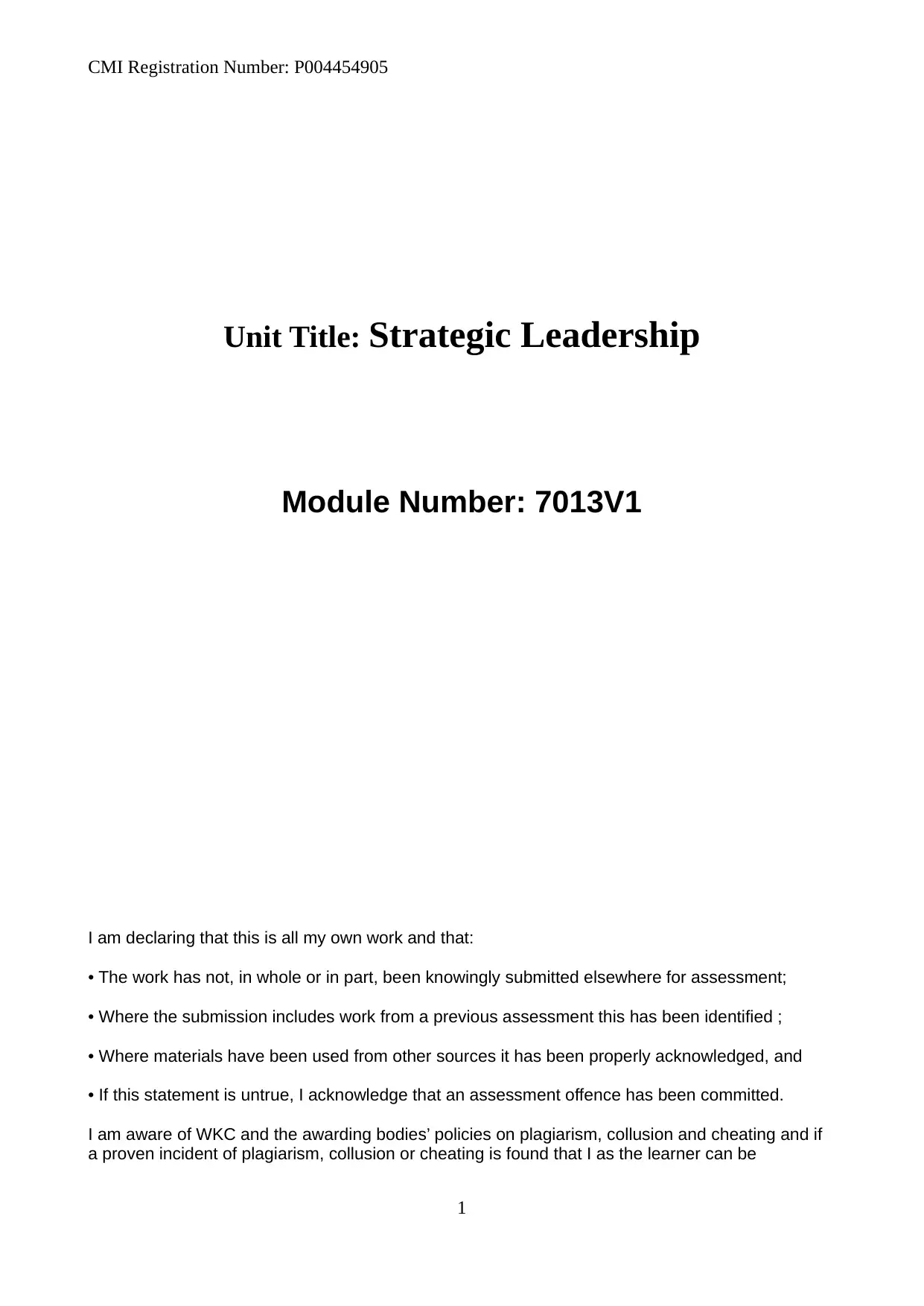
CMI Registration Number: P004454905
Unit Title: Strategic Leadership
Module Number: 7013V1
I am declaring that this is all my own work and that:
• The work has not, in whole or in part, been knowingly submitted elsewhere for assessment;
• Where the submission includes work from a previous assessment this has been identified ;
• Where materials have been used from other sources it has been properly acknowledged, and
• If this statement is untrue, I acknowledge that an assessment offence has been committed.
I am aware of WKC and the awarding bodies’ policies on plagiarism, collusion and cheating and if
a proven incident of plagiarism, collusion or cheating is found that I as the learner can be
1
Unit Title: Strategic Leadership
Module Number: 7013V1
I am declaring that this is all my own work and that:
• The work has not, in whole or in part, been knowingly submitted elsewhere for assessment;
• Where the submission includes work from a previous assessment this has been identified ;
• Where materials have been used from other sources it has been properly acknowledged, and
• If this statement is untrue, I acknowledge that an assessment offence has been committed.
I am aware of WKC and the awarding bodies’ policies on plagiarism, collusion and cheating and if
a proven incident of plagiarism, collusion or cheating is found that I as the learner can be
1
Secure Best Marks with AI Grader
Need help grading? Try our AI Grader for instant feedback on your assignments.

CMI Registration Number: P004454905
withdrawn from the course; that the Home Office will be informed and I may have my registration to
the qualification removed.
2
withdrawn from the course; that the Home Office will be informed and I may have my registration to
the qualification removed.
2
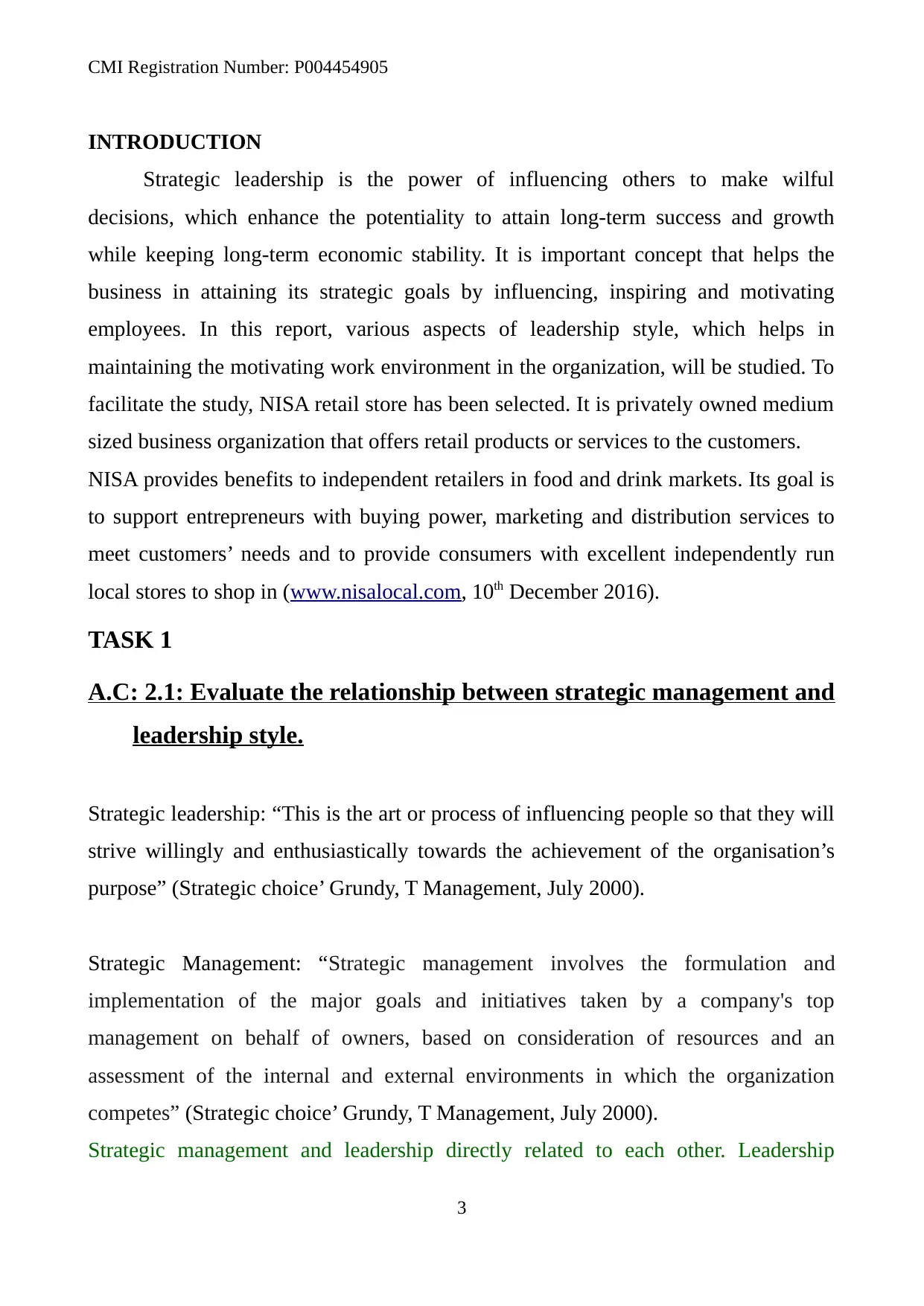
CMI Registration Number: P004454905
INTRODUCTION
Strategic leadership is the power of influencing others to make wilful
decisions, which enhance the potentiality to attain long-term success and growth
while keeping long-term economic stability. It is important concept that helps the
business in attaining its strategic goals by influencing, inspiring and motivating
employees. In this report, various aspects of leadership style, which helps in
maintaining the motivating work environment in the organization, will be studied. To
facilitate the study, NISA retail store has been selected. It is privately owned medium
sized business organization that offers retail products or services to the customers.
NISA provides benefits to independent retailers in food and drink markets. Its goal is
to support entrepreneurs with buying power, marketing and distribution services to
meet customers’ needs and to provide consumers with excellent independently run
local stores to shop in (www.nisalocal.com, 10th December 2016).
TASK 1
A.C: 2.1: Evaluate the relationship between strategic management and
leadership style.
Strategic leadership: “This is the art or process of influencing people so that they will
strive willingly and enthusiastically towards the achievement of the organisation’s
purpose” (Strategic choice’ Grundy, T Management, July 2000).
Strategic Management: “Strategic management involves the formulation and
implementation of the major goals and initiatives taken by a company's top
management on behalf of owners, based on consideration of resources and an
assessment of the internal and external environments in which the organization
competes” (Strategic choice’ Grundy, T Management, July 2000).
Strategic management and leadership directly related to each other. Leadership
3
INTRODUCTION
Strategic leadership is the power of influencing others to make wilful
decisions, which enhance the potentiality to attain long-term success and growth
while keeping long-term economic stability. It is important concept that helps the
business in attaining its strategic goals by influencing, inspiring and motivating
employees. In this report, various aspects of leadership style, which helps in
maintaining the motivating work environment in the organization, will be studied. To
facilitate the study, NISA retail store has been selected. It is privately owned medium
sized business organization that offers retail products or services to the customers.
NISA provides benefits to independent retailers in food and drink markets. Its goal is
to support entrepreneurs with buying power, marketing and distribution services to
meet customers’ needs and to provide consumers with excellent independently run
local stores to shop in (www.nisalocal.com, 10th December 2016).
TASK 1
A.C: 2.1: Evaluate the relationship between strategic management and
leadership style.
Strategic leadership: “This is the art or process of influencing people so that they will
strive willingly and enthusiastically towards the achievement of the organisation’s
purpose” (Strategic choice’ Grundy, T Management, July 2000).
Strategic Management: “Strategic management involves the formulation and
implementation of the major goals and initiatives taken by a company's top
management on behalf of owners, based on consideration of resources and an
assessment of the internal and external environments in which the organization
competes” (Strategic choice’ Grundy, T Management, July 2000).
Strategic management and leadership directly related to each other. Leadership
3
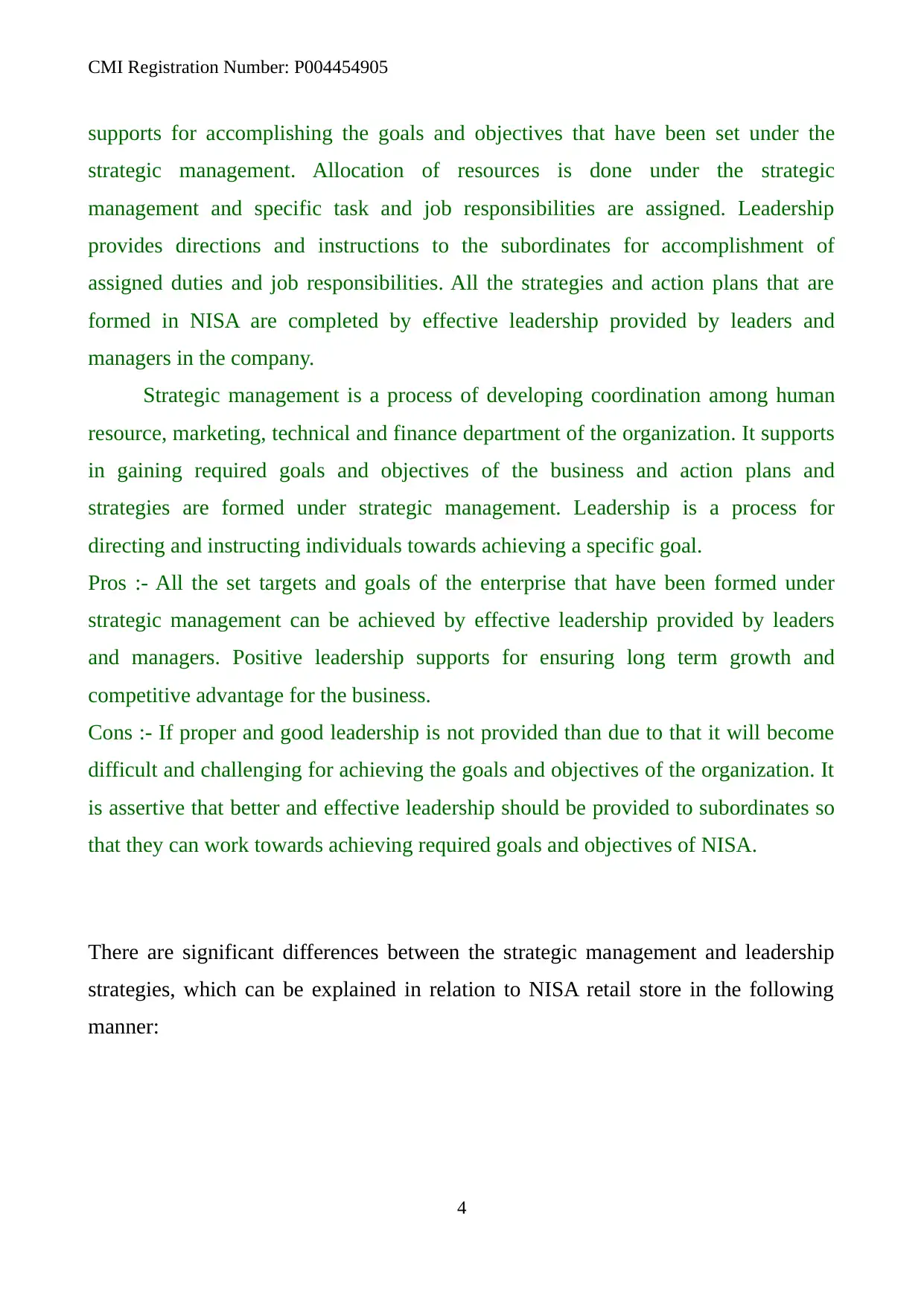
CMI Registration Number: P004454905
supports for accomplishing the goals and objectives that have been set under the
strategic management. Allocation of resources is done under the strategic
management and specific task and job responsibilities are assigned. Leadership
provides directions and instructions to the subordinates for accomplishment of
assigned duties and job responsibilities. All the strategies and action plans that are
formed in NISA are completed by effective leadership provided by leaders and
managers in the company.
Strategic management is a process of developing coordination among human
resource, marketing, technical and finance department of the organization. It supports
in gaining required goals and objectives of the business and action plans and
strategies are formed under strategic management. Leadership is a process for
directing and instructing individuals towards achieving a specific goal.
Pros :- All the set targets and goals of the enterprise that have been formed under
strategic management can be achieved by effective leadership provided by leaders
and managers. Positive leadership supports for ensuring long term growth and
competitive advantage for the business.
Cons :- If proper and good leadership is not provided than due to that it will become
difficult and challenging for achieving the goals and objectives of the organization. It
is assertive that better and effective leadership should be provided to subordinates so
that they can work towards achieving required goals and objectives of NISA.
There are significant differences between the strategic management and leadership
strategies, which can be explained in relation to NISA retail store in the following
manner:
4
supports for accomplishing the goals and objectives that have been set under the
strategic management. Allocation of resources is done under the strategic
management and specific task and job responsibilities are assigned. Leadership
provides directions and instructions to the subordinates for accomplishment of
assigned duties and job responsibilities. All the strategies and action plans that are
formed in NISA are completed by effective leadership provided by leaders and
managers in the company.
Strategic management is a process of developing coordination among human
resource, marketing, technical and finance department of the organization. It supports
in gaining required goals and objectives of the business and action plans and
strategies are formed under strategic management. Leadership is a process for
directing and instructing individuals towards achieving a specific goal.
Pros :- All the set targets and goals of the enterprise that have been formed under
strategic management can be achieved by effective leadership provided by leaders
and managers. Positive leadership supports for ensuring long term growth and
competitive advantage for the business.
Cons :- If proper and good leadership is not provided than due to that it will become
difficult and challenging for achieving the goals and objectives of the organization. It
is assertive that better and effective leadership should be provided to subordinates so
that they can work towards achieving required goals and objectives of NISA.
There are significant differences between the strategic management and leadership
strategies, which can be explained in relation to NISA retail store in the following
manner:
4
Secure Best Marks with AI Grader
Need help grading? Try our AI Grader for instant feedback on your assignments.
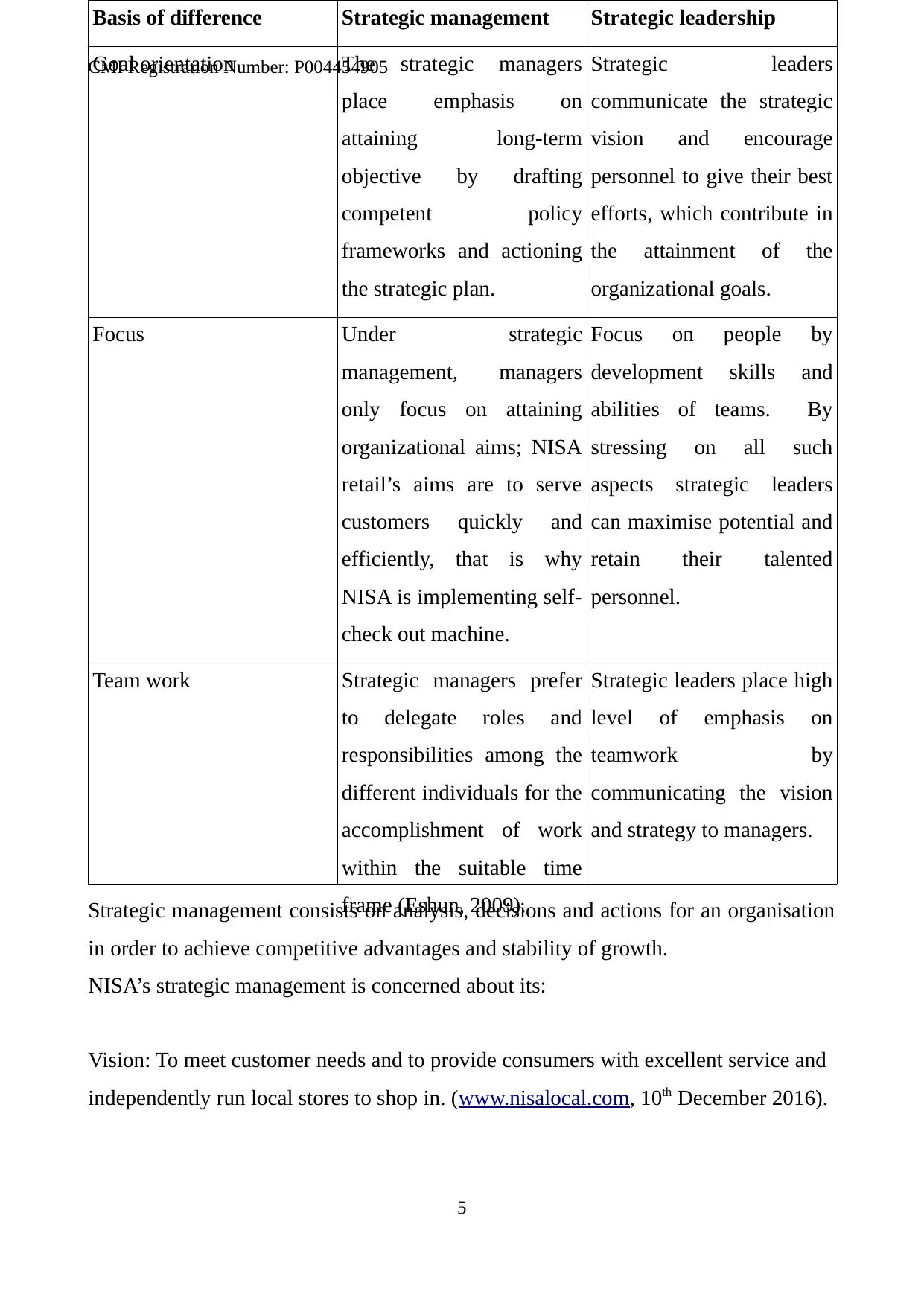
CMI Registration Number: P004454905
Strategic management consists on analysis, decisions and actions for an organisation
in order to achieve competitive advantages and stability of growth.
NISA’s strategic management is concerned about its:
Vision: To meet customer needs and to provide consumers with excellent service and
independently run local stores to shop in. (www.nisalocal.com, 10th December 2016).
5
Basis of difference Strategic management Strategic leadership
Goal orientation The strategic managers
place emphasis on
attaining long-term
objective by drafting
competent policy
frameworks and actioning
the strategic plan.
Strategic leaders
communicate the strategic
vision and encourage
personnel to give their best
efforts, which contribute in
the attainment of the
organizational goals.
Focus Under strategic
management, managers
only focus on attaining
organizational aims; NISA
retail’s aims are to serve
customers quickly and
efficiently, that is why
NISA is implementing self-
check out machine.
Focus on people by
development skills and
abilities of teams. By
stressing on all such
aspects strategic leaders
can maximise potential and
retain their talented
personnel.
Team work Strategic managers prefer
to delegate roles and
responsibilities among the
different individuals for the
accomplishment of work
within the suitable time
frame (Eshun, 2009).
Strategic leaders place high
level of emphasis on
teamwork by
communicating the vision
and strategy to managers.
Strategic management consists on analysis, decisions and actions for an organisation
in order to achieve competitive advantages and stability of growth.
NISA’s strategic management is concerned about its:
Vision: To meet customer needs and to provide consumers with excellent service and
independently run local stores to shop in. (www.nisalocal.com, 10th December 2016).
5
Basis of difference Strategic management Strategic leadership
Goal orientation The strategic managers
place emphasis on
attaining long-term
objective by drafting
competent policy
frameworks and actioning
the strategic plan.
Strategic leaders
communicate the strategic
vision and encourage
personnel to give their best
efforts, which contribute in
the attainment of the
organizational goals.
Focus Under strategic
management, managers
only focus on attaining
organizational aims; NISA
retail’s aims are to serve
customers quickly and
efficiently, that is why
NISA is implementing self-
check out machine.
Focus on people by
development skills and
abilities of teams. By
stressing on all such
aspects strategic leaders
can maximise potential and
retain their talented
personnel.
Team work Strategic managers prefer
to delegate roles and
responsibilities among the
different individuals for the
accomplishment of work
within the suitable time
frame (Eshun, 2009).
Strategic leaders place high
level of emphasis on
teamwork by
communicating the vision
and strategy to managers.
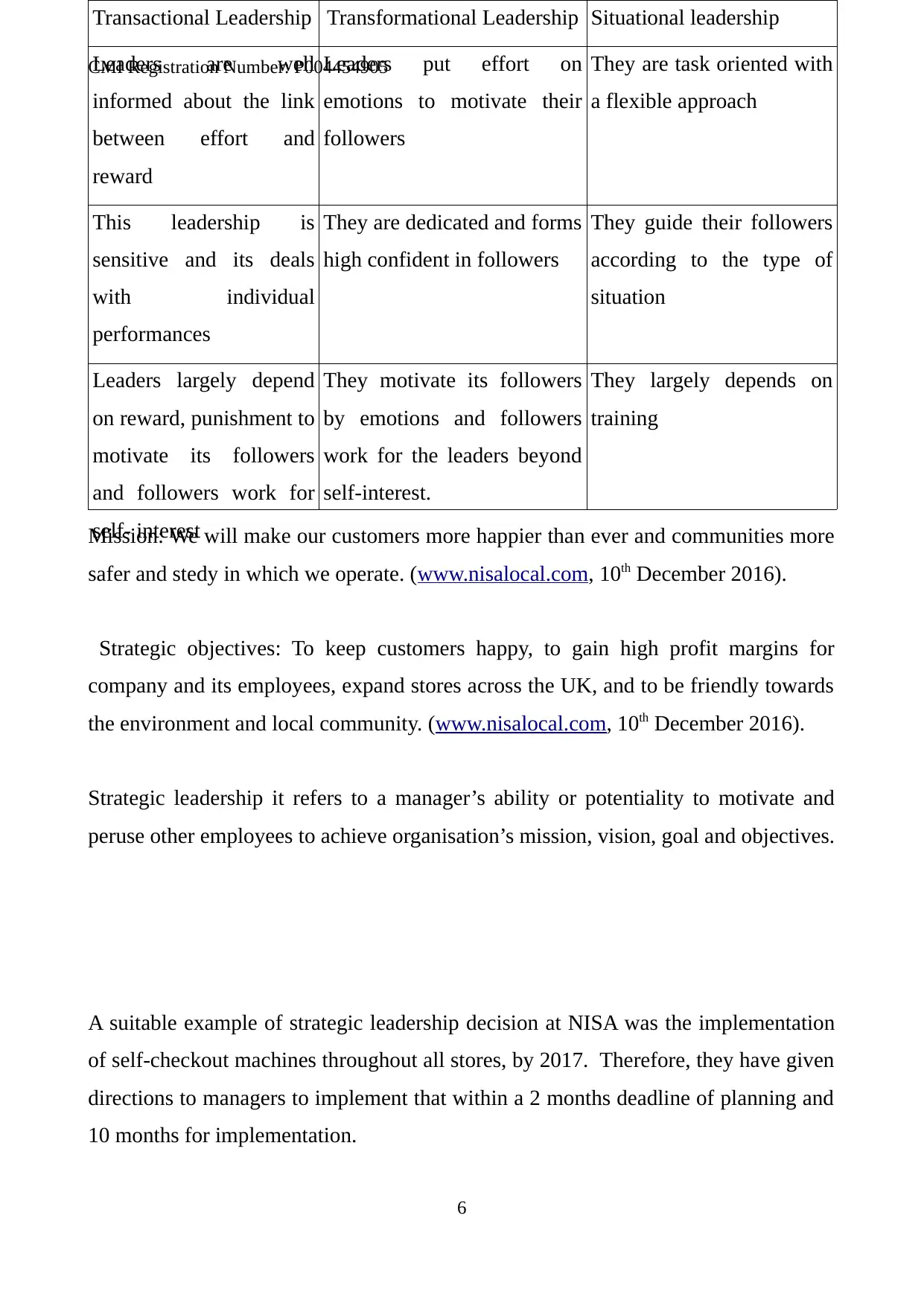
CMI Registration Number: P004454905
Mission: We will make our customers more happier than ever and communities more
safer and stedy in which we operate. (www.nisalocal.com, 10th December 2016).
Strategic objectives: To keep customers happy, to gain high profit margins for
company and its employees, expand stores across the UK, and to be friendly towards
the environment and local community. (www.nisalocal.com, 10th December 2016).
Strategic leadership it refers to a manager’s ability or potentiality to motivate and
peruse other employees to achieve organisation’s mission, vision, goal and objectives.
A suitable example of strategic leadership decision at NISA was the implementation
of self-checkout machines throughout all stores, by 2017. Therefore, they have given
directions to managers to implement that within a 2 months deadline of planning and
10 months for implementation.
6
Transactional Leadership Transformational Leadership Situational leadership
Leaders are well
informed about the link
between effort and
reward
Leaders put effort on
emotions to motivate their
followers
They are task oriented with
a flexible approach
This leadership is
sensitive and its deals
with individual
performances
They are dedicated and forms
high confident in followers
They guide their followers
according to the type of
situation
Leaders largely depend
on reward, punishment to
motivate its followers
and followers work for
self- interest
They motivate its followers
by emotions and followers
work for the leaders beyond
self-interest.
They largely depends on
training
Mission: We will make our customers more happier than ever and communities more
safer and stedy in which we operate. (www.nisalocal.com, 10th December 2016).
Strategic objectives: To keep customers happy, to gain high profit margins for
company and its employees, expand stores across the UK, and to be friendly towards
the environment and local community. (www.nisalocal.com, 10th December 2016).
Strategic leadership it refers to a manager’s ability or potentiality to motivate and
peruse other employees to achieve organisation’s mission, vision, goal and objectives.
A suitable example of strategic leadership decision at NISA was the implementation
of self-checkout machines throughout all stores, by 2017. Therefore, they have given
directions to managers to implement that within a 2 months deadline of planning and
10 months for implementation.
6
Transactional Leadership Transformational Leadership Situational leadership
Leaders are well
informed about the link
between effort and
reward
Leaders put effort on
emotions to motivate their
followers
They are task oriented with
a flexible approach
This leadership is
sensitive and its deals
with individual
performances
They are dedicated and forms
high confident in followers
They guide their followers
according to the type of
situation
Leaders largely depend
on reward, punishment to
motivate its followers
and followers work for
self- interest
They motivate its followers
by emotions and followers
work for the leaders beyond
self-interest.
They largely depends on
training
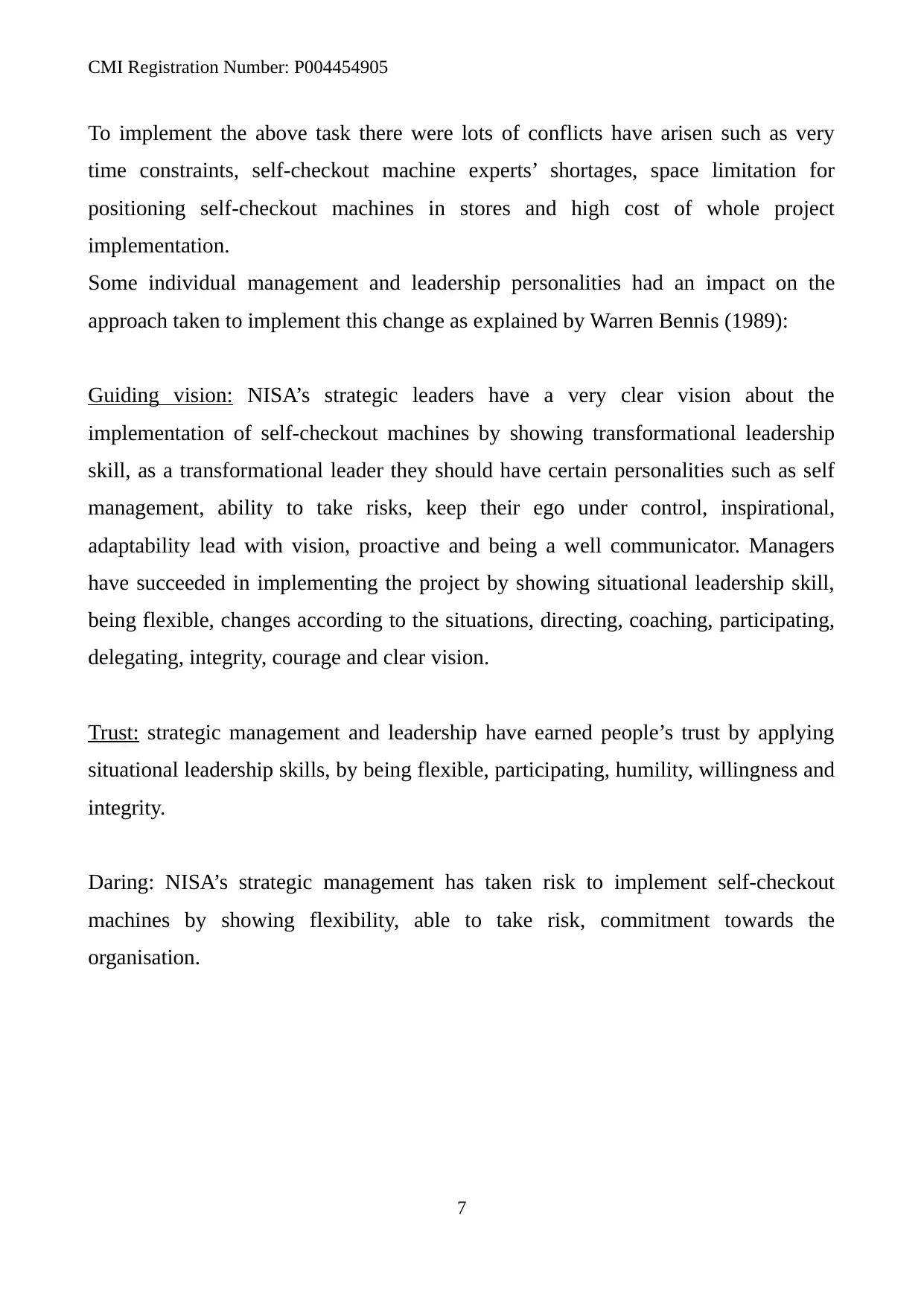
CMI Registration Number: P004454905
To implement the above task there were lots of conflicts have arisen such as very
time constraints, self-checkout machine experts’ shortages, space limitation for
positioning self-checkout machines in stores and high cost of whole project
implementation.
Some individual management and leadership personalities had an impact on the
approach taken to implement this change as explained by Warren Bennis (1989):
Guiding vision: NISA’s strategic leaders have a very clear vision about the
implementation of self-checkout machines by showing transformational leadership
skill, as a transformational leader they should have certain personalities such as self
management, ability to take risks, keep their ego under control, inspirational,
adaptability lead with vision, proactive and being a well communicator. Managers
have succeeded in implementing the project by showing situational leadership skill,
being flexible, changes according to the situations, directing, coaching, participating,
delegating, integrity, courage and clear vision.
Trust: strategic management and leadership have earned people’s trust by applying
situational leadership skills, by being flexible, participating, humility, willingness and
integrity.
Daring: NISA’s strategic management has taken risk to implement self-checkout
machines by showing flexibility, able to take risk, commitment towards the
organisation.
7
To implement the above task there were lots of conflicts have arisen such as very
time constraints, self-checkout machine experts’ shortages, space limitation for
positioning self-checkout machines in stores and high cost of whole project
implementation.
Some individual management and leadership personalities had an impact on the
approach taken to implement this change as explained by Warren Bennis (1989):
Guiding vision: NISA’s strategic leaders have a very clear vision about the
implementation of self-checkout machines by showing transformational leadership
skill, as a transformational leader they should have certain personalities such as self
management, ability to take risks, keep their ego under control, inspirational,
adaptability lead with vision, proactive and being a well communicator. Managers
have succeeded in implementing the project by showing situational leadership skill,
being flexible, changes according to the situations, directing, coaching, participating,
delegating, integrity, courage and clear vision.
Trust: strategic management and leadership have earned people’s trust by applying
situational leadership skills, by being flexible, participating, humility, willingness and
integrity.
Daring: NISA’s strategic management has taken risk to implement self-checkout
machines by showing flexibility, able to take risk, commitment towards the
organisation.
7
Paraphrase This Document
Need a fresh take? Get an instant paraphrase of this document with our AI Paraphraser
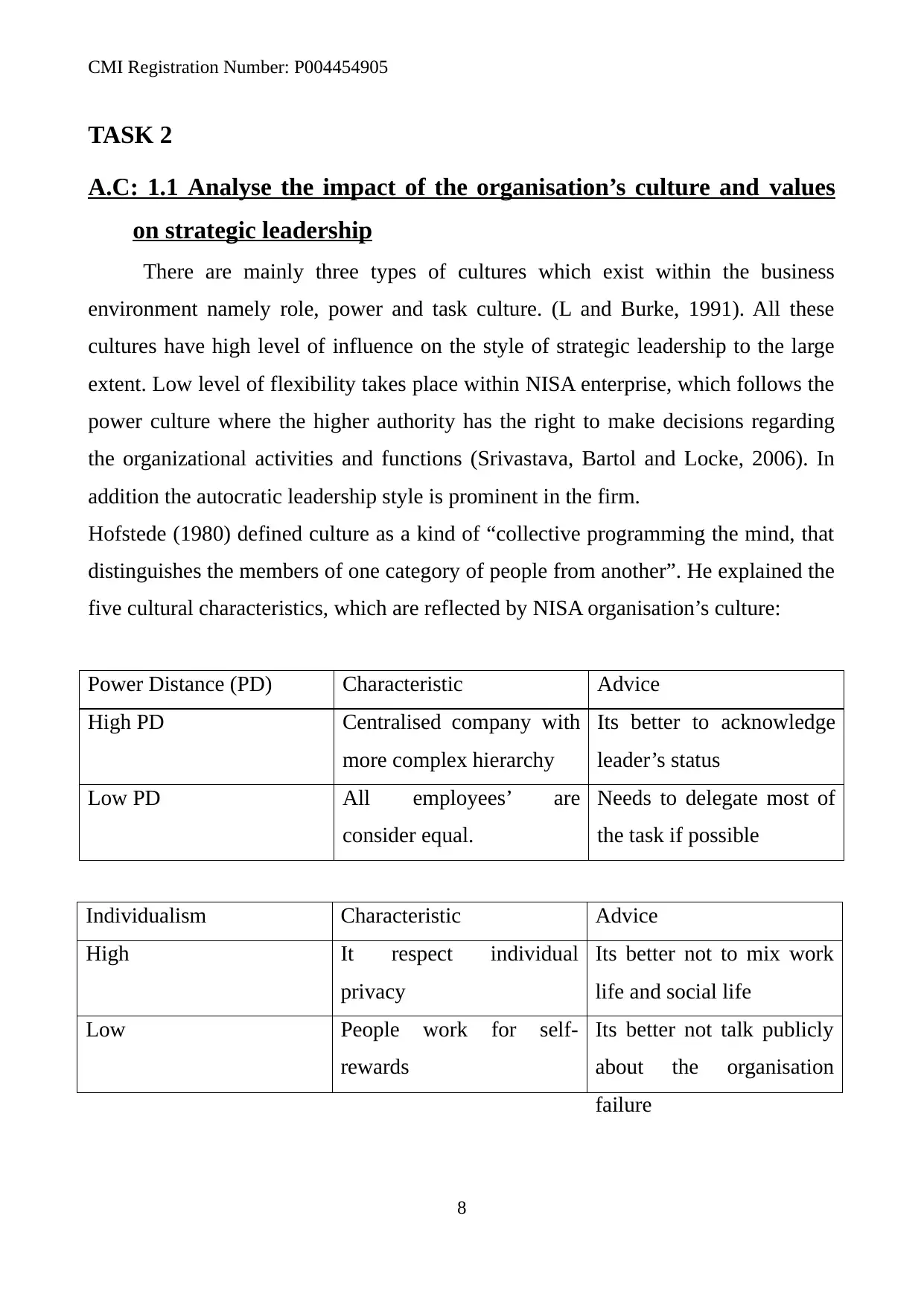
CMI Registration Number: P004454905
TASK 2
A.C: 1.1 Analyse the impact of the organisation’s culture and values
on strategic leadership
There are mainly three types of cultures which exist within the business
environment namely role, power and task culture. (L and Burke, 1991). All these
cultures have high level of influence on the style of strategic leadership to the large
extent. Low level of flexibility takes place within NISA enterprise, which follows the
power culture where the higher authority has the right to make decisions regarding
the organizational activities and functions (Srivastava, Bartol and Locke, 2006). In
addition the autocratic leadership style is prominent in the firm.
Hofstede (1980) defined culture as a kind of “collective programming the mind, that
distinguishes the members of one category of people from another”. He explained the
five cultural characteristics, which are reflected by NISA organisation’s culture:
Power Distance (PD) Characteristic Advice
High PD Centralised company with
more complex hierarchy
Its better to acknowledge
leader’s status
Low PD All employees’ are
consider equal.
Needs to delegate most of
the task if possible
8
Individualism Characteristic Advice
High It respect individual
privacy
Its better not to mix work
life and social life
Low People work for self-
rewards
Its better not talk publicly
about the organisation
failure
TASK 2
A.C: 1.1 Analyse the impact of the organisation’s culture and values
on strategic leadership
There are mainly three types of cultures which exist within the business
environment namely role, power and task culture. (L and Burke, 1991). All these
cultures have high level of influence on the style of strategic leadership to the large
extent. Low level of flexibility takes place within NISA enterprise, which follows the
power culture where the higher authority has the right to make decisions regarding
the organizational activities and functions (Srivastava, Bartol and Locke, 2006). In
addition the autocratic leadership style is prominent in the firm.
Hofstede (1980) defined culture as a kind of “collective programming the mind, that
distinguishes the members of one category of people from another”. He explained the
five cultural characteristics, which are reflected by NISA organisation’s culture:
Power Distance (PD) Characteristic Advice
High PD Centralised company with
more complex hierarchy
Its better to acknowledge
leader’s status
Low PD All employees’ are
consider equal.
Needs to delegate most of
the task if possible
8
Individualism Characteristic Advice
High It respect individual
privacy
Its better not to mix work
life and social life
Low People work for self-
rewards
Its better not talk publicly
about the organisation
failure
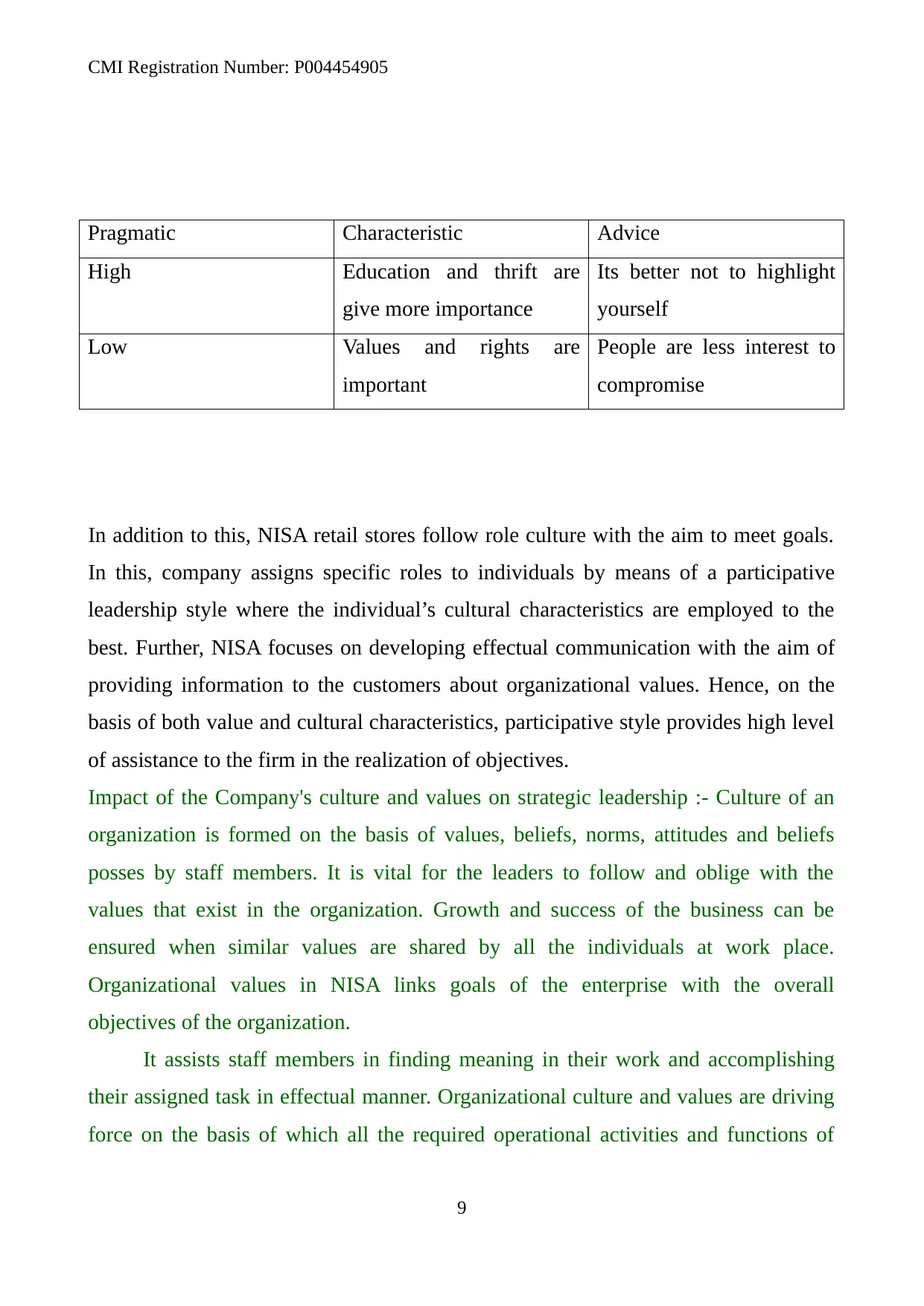
CMI Registration Number: P004454905
Pragmatic Characteristic Advice
High Education and thrift are
give more importance
Its better not to highlight
yourself
Low Values and rights are
important
People are less interest to
compromise
In addition to this, NISA retail stores follow role culture with the aim to meet goals.
In this, company assigns specific roles to individuals by means of a participative
leadership style where the individual’s cultural characteristics are employed to the
best. Further, NISA focuses on developing effectual communication with the aim of
providing information to the customers about organizational values. Hence, on the
basis of both value and cultural characteristics, participative style provides high level
of assistance to the firm in the realization of objectives.
Impact of the Company's culture and values on strategic leadership :- Culture of an
organization is formed on the basis of values, beliefs, norms, attitudes and beliefs
posses by staff members. It is vital for the leaders to follow and oblige with the
values that exist in the organization. Growth and success of the business can be
ensured when similar values are shared by all the individuals at work place.
Organizational values in NISA links goals of the enterprise with the overall
objectives of the organization.
It assists staff members in finding meaning in their work and accomplishing
their assigned task in effectual manner. Organizational culture and values are driving
force on the basis of which all the required operational activities and functions of
9
Pragmatic Characteristic Advice
High Education and thrift are
give more importance
Its better not to highlight
yourself
Low Values and rights are
important
People are less interest to
compromise
In addition to this, NISA retail stores follow role culture with the aim to meet goals.
In this, company assigns specific roles to individuals by means of a participative
leadership style where the individual’s cultural characteristics are employed to the
best. Further, NISA focuses on developing effectual communication with the aim of
providing information to the customers about organizational values. Hence, on the
basis of both value and cultural characteristics, participative style provides high level
of assistance to the firm in the realization of objectives.
Impact of the Company's culture and values on strategic leadership :- Culture of an
organization is formed on the basis of values, beliefs, norms, attitudes and beliefs
posses by staff members. It is vital for the leaders to follow and oblige with the
values that exist in the organization. Growth and success of the business can be
ensured when similar values are shared by all the individuals at work place.
Organizational values in NISA links goals of the enterprise with the overall
objectives of the organization.
It assists staff members in finding meaning in their work and accomplishing
their assigned task in effectual manner. Organizational culture and values are driving
force on the basis of which all the required operational activities and functions of
9
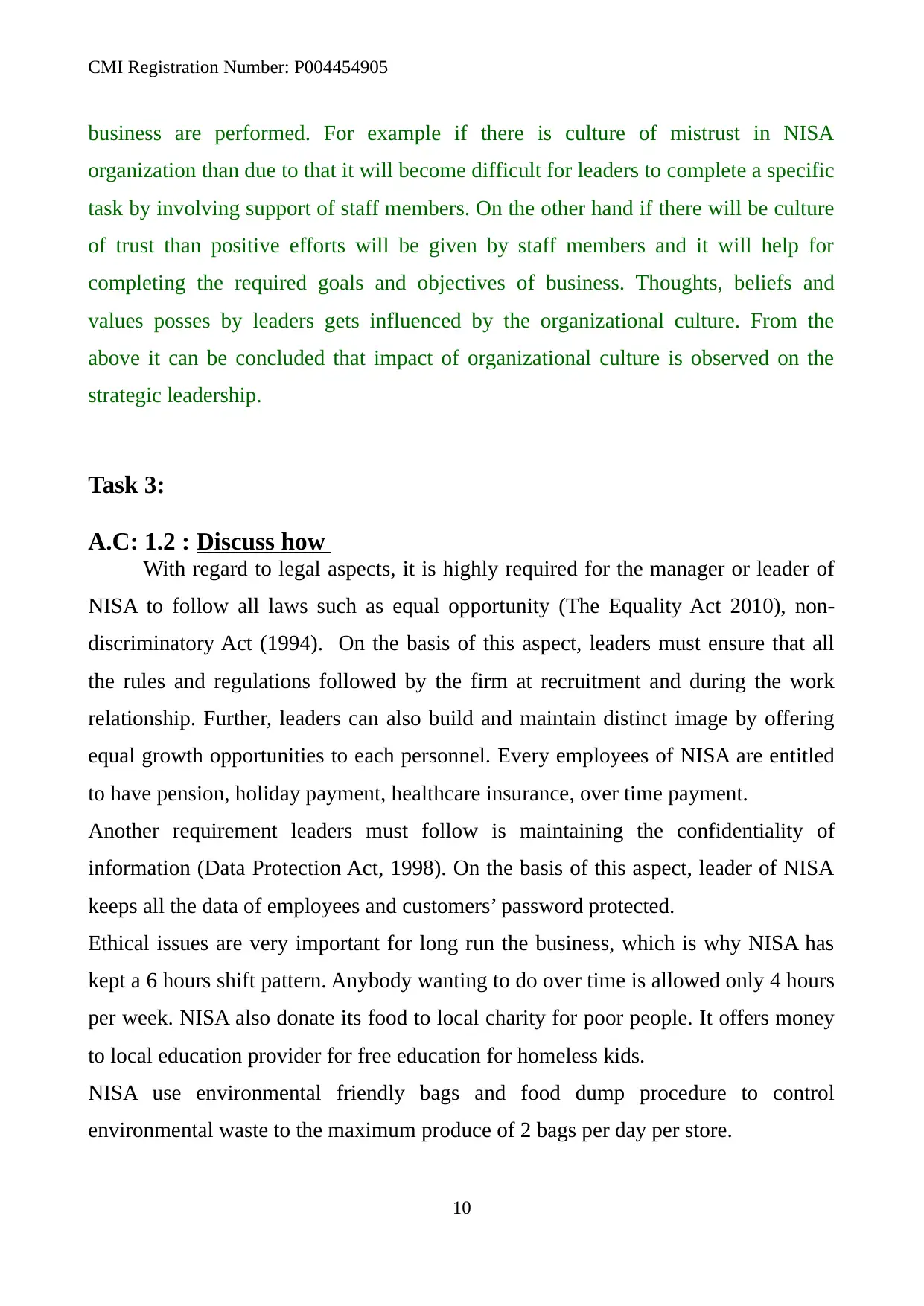
CMI Registration Number: P004454905
business are performed. For example if there is culture of mistrust in NISA
organization than due to that it will become difficult for leaders to complete a specific
task by involving support of staff members. On the other hand if there will be culture
of trust than positive efforts will be given by staff members and it will help for
completing the required goals and objectives of business. Thoughts, beliefs and
values posses by leaders gets influenced by the organizational culture. From the
above it can be concluded that impact of organizational culture is observed on the
strategic leadership.
Task 3:
A.C: 1.2 : Discuss how
With regard to legal aspects, it is highly required for the manager or leader of
NISA to follow all laws such as equal opportunity (The Equality Act 2010), non-
discriminatory Act (1994). On the basis of this aspect, leaders must ensure that all
the rules and regulations followed by the firm at recruitment and during the work
relationship. Further, leaders can also build and maintain distinct image by offering
equal growth opportunities to each personnel. Every employees of NISA are entitled
to have pension, holiday payment, healthcare insurance, over time payment.
Another requirement leaders must follow is maintaining the confidentiality of
information (Data Protection Act, 1998). On the basis of this aspect, leader of NISA
keeps all the data of employees and customers’ password protected.
Ethical issues are very important for long run the business, which is why NISA has
kept a 6 hours shift pattern. Anybody wanting to do over time is allowed only 4 hours
per week. NISA also donate its food to local charity for poor people. It offers money
to local education provider for free education for homeless kids.
NISA use environmental friendly bags and food dump procedure to control
environmental waste to the maximum produce of 2 bags per day per store.
10
business are performed. For example if there is culture of mistrust in NISA
organization than due to that it will become difficult for leaders to complete a specific
task by involving support of staff members. On the other hand if there will be culture
of trust than positive efforts will be given by staff members and it will help for
completing the required goals and objectives of business. Thoughts, beliefs and
values posses by leaders gets influenced by the organizational culture. From the
above it can be concluded that impact of organizational culture is observed on the
strategic leadership.
Task 3:
A.C: 1.2 : Discuss how
With regard to legal aspects, it is highly required for the manager or leader of
NISA to follow all laws such as equal opportunity (The Equality Act 2010), non-
discriminatory Act (1994). On the basis of this aspect, leaders must ensure that all
the rules and regulations followed by the firm at recruitment and during the work
relationship. Further, leaders can also build and maintain distinct image by offering
equal growth opportunities to each personnel. Every employees of NISA are entitled
to have pension, holiday payment, healthcare insurance, over time payment.
Another requirement leaders must follow is maintaining the confidentiality of
information (Data Protection Act, 1998). On the basis of this aspect, leader of NISA
keeps all the data of employees and customers’ password protected.
Ethical issues are very important for long run the business, which is why NISA has
kept a 6 hours shift pattern. Anybody wanting to do over time is allowed only 4 hours
per week. NISA also donate its food to local charity for poor people. It offers money
to local education provider for free education for homeless kids.
NISA use environmental friendly bags and food dump procedure to control
environmental waste to the maximum produce of 2 bags per day per store.
10
Secure Best Marks with AI Grader
Need help grading? Try our AI Grader for instant feedback on your assignments.
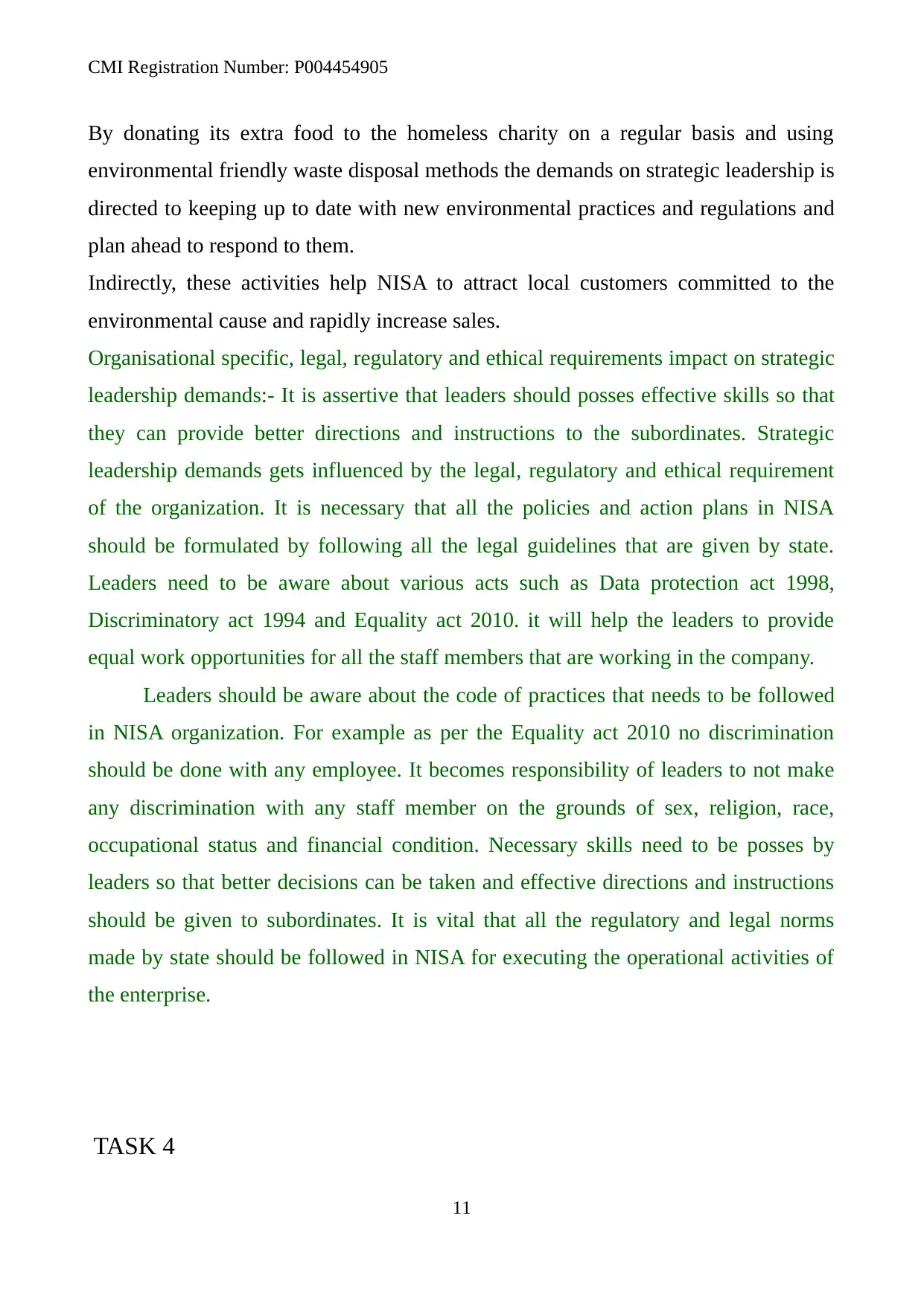
CMI Registration Number: P004454905
By donating its extra food to the homeless charity on a regular basis and using
environmental friendly waste disposal methods the demands on strategic leadership is
directed to keeping up to date with new environmental practices and regulations and
plan ahead to respond to them.
Indirectly, these activities help NISA to attract local customers committed to the
environmental cause and rapidly increase sales.
Organisational specific, legal, regulatory and ethical requirements impact on strategic
leadership demands:- It is assertive that leaders should posses effective skills so that
they can provide better directions and instructions to the subordinates. Strategic
leadership demands gets influenced by the legal, regulatory and ethical requirement
of the organization. It is necessary that all the policies and action plans in NISA
should be formulated by following all the legal guidelines that are given by state.
Leaders need to be aware about various acts such as Data protection act 1998,
Discriminatory act 1994 and Equality act 2010. it will help the leaders to provide
equal work opportunities for all the staff members that are working in the company.
Leaders should be aware about the code of practices that needs to be followed
in NISA organization. For example as per the Equality act 2010 no discrimination
should be done with any employee. It becomes responsibility of leaders to not make
any discrimination with any staff member on the grounds of sex, religion, race,
occupational status and financial condition. Necessary skills need to be posses by
leaders so that better decisions can be taken and effective directions and instructions
should be given to subordinates. It is vital that all the regulatory and legal norms
made by state should be followed in NISA for executing the operational activities of
the enterprise.
TASK 4
11
By donating its extra food to the homeless charity on a regular basis and using
environmental friendly waste disposal methods the demands on strategic leadership is
directed to keeping up to date with new environmental practices and regulations and
plan ahead to respond to them.
Indirectly, these activities help NISA to attract local customers committed to the
environmental cause and rapidly increase sales.
Organisational specific, legal, regulatory and ethical requirements impact on strategic
leadership demands:- It is assertive that leaders should posses effective skills so that
they can provide better directions and instructions to the subordinates. Strategic
leadership demands gets influenced by the legal, regulatory and ethical requirement
of the organization. It is necessary that all the policies and action plans in NISA
should be formulated by following all the legal guidelines that are given by state.
Leaders need to be aware about various acts such as Data protection act 1998,
Discriminatory act 1994 and Equality act 2010. it will help the leaders to provide
equal work opportunities for all the staff members that are working in the company.
Leaders should be aware about the code of practices that needs to be followed
in NISA organization. For example as per the Equality act 2010 no discrimination
should be done with any employee. It becomes responsibility of leaders to not make
any discrimination with any staff member on the grounds of sex, religion, race,
occupational status and financial condition. Necessary skills need to be posses by
leaders so that better decisions can be taken and effective directions and instructions
should be given to subordinates. It is vital that all the regulatory and legal norms
made by state should be followed in NISA for executing the operational activities of
the enterprise.
TASK 4
11
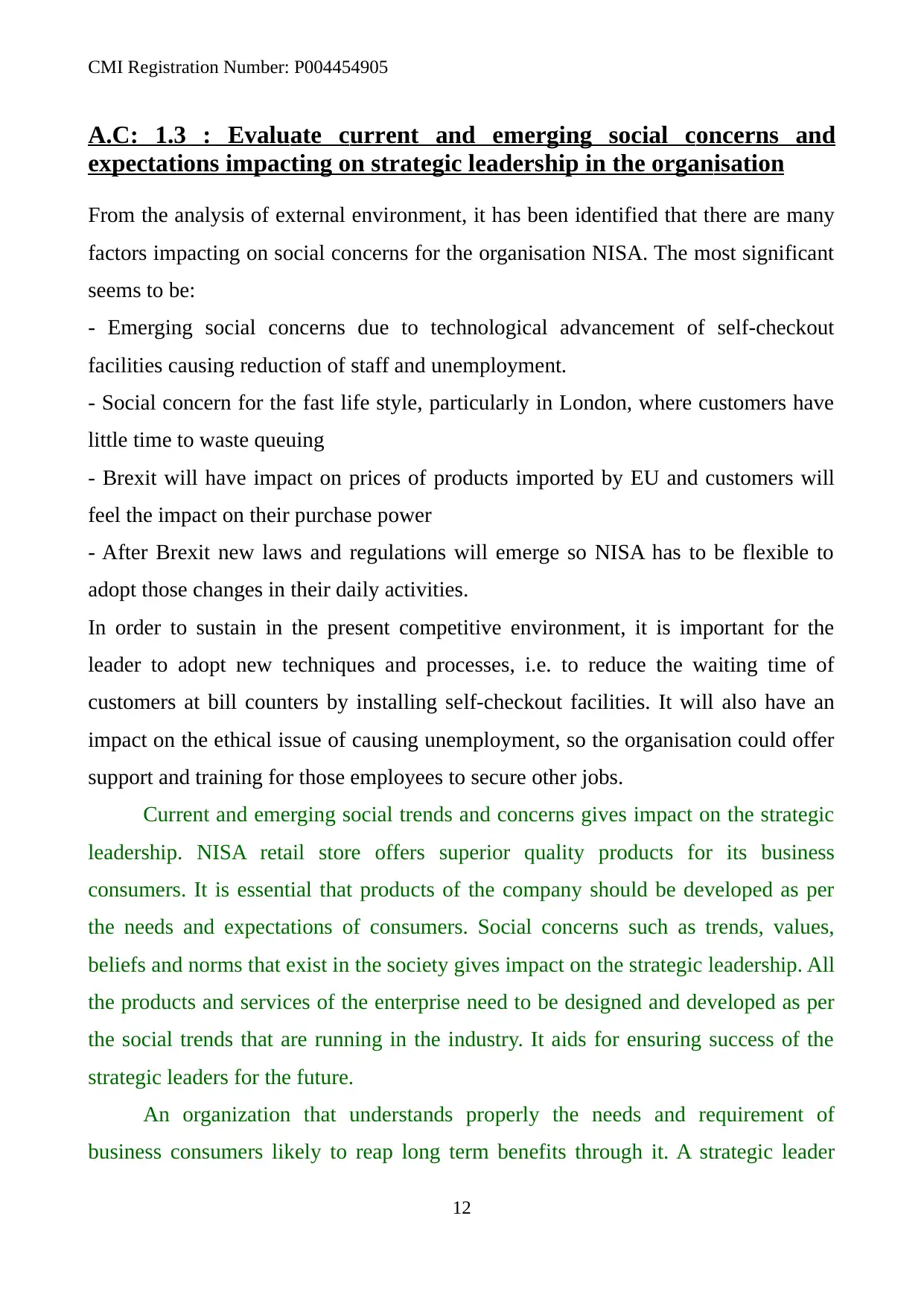
CMI Registration Number: P004454905
A.C: 1.3 : Evaluate current and emerging social concerns and
expectations impacting on strategic leadership in the organisation
From the analysis of external environment, it has been identified that there are many
factors impacting on social concerns for the organisation NISA. The most significant
seems to be:
- Emerging social concerns due to technological advancement of self-checkout
facilities causing reduction of staff and unemployment.
- Social concern for the fast life style, particularly in London, where customers have
little time to waste queuing
- Brexit will have impact on prices of products imported by EU and customers will
feel the impact on their purchase power
- After Brexit new laws and regulations will emerge so NISA has to be flexible to
adopt those changes in their daily activities.
In order to sustain in the present competitive environment, it is important for the
leader to adopt new techniques and processes, i.e. to reduce the waiting time of
customers at bill counters by installing self-checkout facilities. It will also have an
impact on the ethical issue of causing unemployment, so the organisation could offer
support and training for those employees to secure other jobs.
Current and emerging social trends and concerns gives impact on the strategic
leadership. NISA retail store offers superior quality products for its business
consumers. It is essential that products of the company should be developed as per
the needs and expectations of consumers. Social concerns such as trends, values,
beliefs and norms that exist in the society gives impact on the strategic leadership. All
the products and services of the enterprise need to be designed and developed as per
the social trends that are running in the industry. It aids for ensuring success of the
strategic leaders for the future.
An organization that understands properly the needs and requirement of
business consumers likely to reap long term benefits through it. A strategic leader
12
A.C: 1.3 : Evaluate current and emerging social concerns and
expectations impacting on strategic leadership in the organisation
From the analysis of external environment, it has been identified that there are many
factors impacting on social concerns for the organisation NISA. The most significant
seems to be:
- Emerging social concerns due to technological advancement of self-checkout
facilities causing reduction of staff and unemployment.
- Social concern for the fast life style, particularly in London, where customers have
little time to waste queuing
- Brexit will have impact on prices of products imported by EU and customers will
feel the impact on their purchase power
- After Brexit new laws and regulations will emerge so NISA has to be flexible to
adopt those changes in their daily activities.
In order to sustain in the present competitive environment, it is important for the
leader to adopt new techniques and processes, i.e. to reduce the waiting time of
customers at bill counters by installing self-checkout facilities. It will also have an
impact on the ethical issue of causing unemployment, so the organisation could offer
support and training for those employees to secure other jobs.
Current and emerging social trends and concerns gives impact on the strategic
leadership. NISA retail store offers superior quality products for its business
consumers. It is essential that products of the company should be developed as per
the needs and expectations of consumers. Social concerns such as trends, values,
beliefs and norms that exist in the society gives impact on the strategic leadership. All
the products and services of the enterprise need to be designed and developed as per
the social trends that are running in the industry. It aids for ensuring success of the
strategic leaders for the future.
An organization that understands properly the needs and requirement of
business consumers likely to reap long term benefits through it. A strategic leader
12
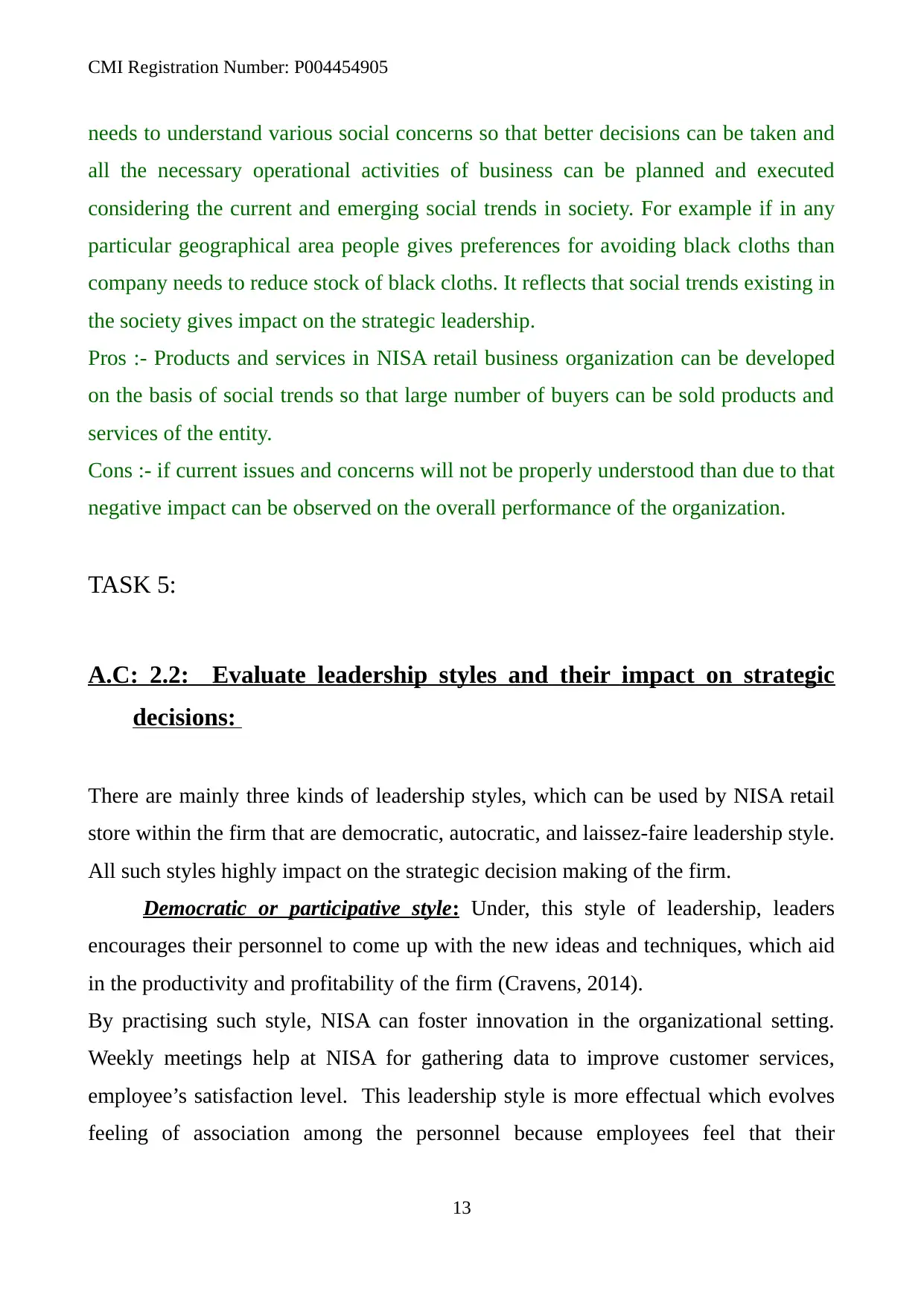
CMI Registration Number: P004454905
needs to understand various social concerns so that better decisions can be taken and
all the necessary operational activities of business can be planned and executed
considering the current and emerging social trends in society. For example if in any
particular geographical area people gives preferences for avoiding black cloths than
company needs to reduce stock of black cloths. It reflects that social trends existing in
the society gives impact on the strategic leadership.
Pros :- Products and services in NISA retail business organization can be developed
on the basis of social trends so that large number of buyers can be sold products and
services of the entity.
Cons :- if current issues and concerns will not be properly understood than due to that
negative impact can be observed on the overall performance of the organization.
TASK 5:
A.C: 2.2: Evaluate leadership styles and their impact on strategic
decisions:
There are mainly three kinds of leadership styles, which can be used by NISA retail
store within the firm that are democratic, autocratic, and laissez-faire leadership style.
All such styles highly impact on the strategic decision making of the firm.
Democratic or participative style: Under, this style of leadership, leaders
encourages their personnel to come up with the new ideas and techniques, which aid
in the productivity and profitability of the firm (Cravens, 2014).
By practising such style, NISA can foster innovation in the organizational setting.
Weekly meetings help at NISA for gathering data to improve customer services,
employee’s satisfaction level. This leadership style is more effectual which evolves
feeling of association among the personnel because employees feel that their
13
needs to understand various social concerns so that better decisions can be taken and
all the necessary operational activities of business can be planned and executed
considering the current and emerging social trends in society. For example if in any
particular geographical area people gives preferences for avoiding black cloths than
company needs to reduce stock of black cloths. It reflects that social trends existing in
the society gives impact on the strategic leadership.
Pros :- Products and services in NISA retail business organization can be developed
on the basis of social trends so that large number of buyers can be sold products and
services of the entity.
Cons :- if current issues and concerns will not be properly understood than due to that
negative impact can be observed on the overall performance of the organization.
TASK 5:
A.C: 2.2: Evaluate leadership styles and their impact on strategic
decisions:
There are mainly three kinds of leadership styles, which can be used by NISA retail
store within the firm that are democratic, autocratic, and laissez-faire leadership style.
All such styles highly impact on the strategic decision making of the firm.
Democratic or participative style: Under, this style of leadership, leaders
encourages their personnel to come up with the new ideas and techniques, which aid
in the productivity and profitability of the firm (Cravens, 2014).
By practising such style, NISA can foster innovation in the organizational setting.
Weekly meetings help at NISA for gathering data to improve customer services,
employee’s satisfaction level. This leadership style is more effectual which evolves
feeling of association among the personnel because employees feel that their
13
Paraphrase This Document
Need a fresh take? Get an instant paraphrase of this document with our AI Paraphraser
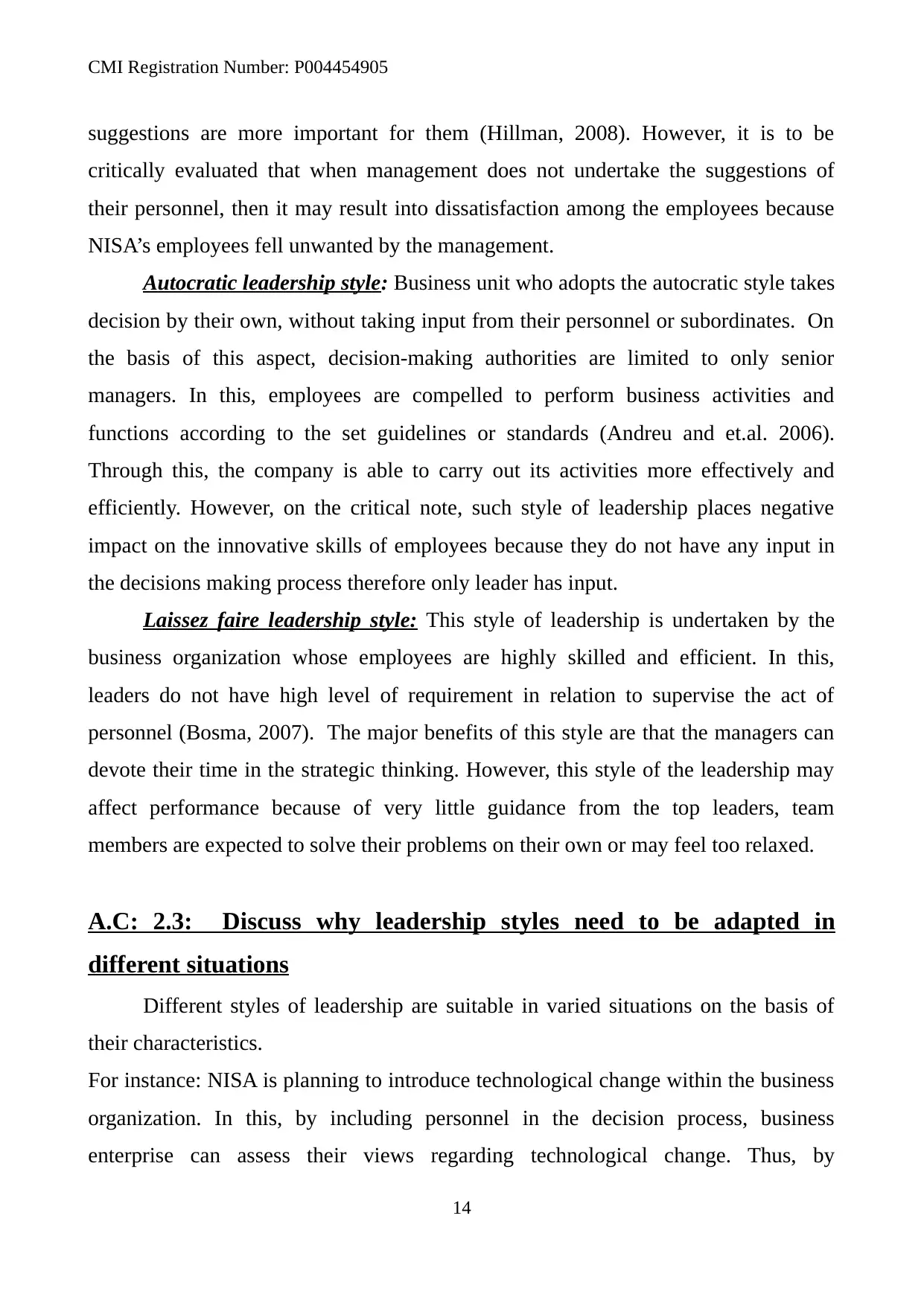
CMI Registration Number: P004454905
suggestions are more important for them (Hillman, 2008). However, it is to be
critically evaluated that when management does not undertake the suggestions of
their personnel, then it may result into dissatisfaction among the employees because
NISA’s employees fell unwanted by the management.
Autocratic leadership style: Business unit who adopts the autocratic style takes
decision by their own, without taking input from their personnel or subordinates. On
the basis of this aspect, decision-making authorities are limited to only senior
managers. In this, employees are compelled to perform business activities and
functions according to the set guidelines or standards (Andreu and et.al. 2006).
Through this, the company is able to carry out its activities more effectively and
efficiently. However, on the critical note, such style of leadership places negative
impact on the innovative skills of employees because they do not have any input in
the decisions making process therefore only leader has input.
Laissez faire leadership style: This style of leadership is undertaken by the
business organization whose employees are highly skilled and efficient. In this,
leaders do not have high level of requirement in relation to supervise the act of
personnel (Bosma, 2007). The major benefits of this style are that the managers can
devote their time in the strategic thinking. However, this style of the leadership may
affect performance because of very little guidance from the top leaders, team
members are expected to solve their problems on their own or may feel too relaxed.
A.C: 2.3: Discuss why leadership styles need to be adapted in
different situations
Different styles of leadership are suitable in varied situations on the basis of
their characteristics.
For instance: NISA is planning to introduce technological change within the business
organization. In this, by including personnel in the decision process, business
enterprise can assess their views regarding technological change. Thus, by
14
suggestions are more important for them (Hillman, 2008). However, it is to be
critically evaluated that when management does not undertake the suggestions of
their personnel, then it may result into dissatisfaction among the employees because
NISA’s employees fell unwanted by the management.
Autocratic leadership style: Business unit who adopts the autocratic style takes
decision by their own, without taking input from their personnel or subordinates. On
the basis of this aspect, decision-making authorities are limited to only senior
managers. In this, employees are compelled to perform business activities and
functions according to the set guidelines or standards (Andreu and et.al. 2006).
Through this, the company is able to carry out its activities more effectively and
efficiently. However, on the critical note, such style of leadership places negative
impact on the innovative skills of employees because they do not have any input in
the decisions making process therefore only leader has input.
Laissez faire leadership style: This style of leadership is undertaken by the
business organization whose employees are highly skilled and efficient. In this,
leaders do not have high level of requirement in relation to supervise the act of
personnel (Bosma, 2007). The major benefits of this style are that the managers can
devote their time in the strategic thinking. However, this style of the leadership may
affect performance because of very little guidance from the top leaders, team
members are expected to solve their problems on their own or may feel too relaxed.
A.C: 2.3: Discuss why leadership styles need to be adapted in
different situations
Different styles of leadership are suitable in varied situations on the basis of
their characteristics.
For instance: NISA is planning to introduce technological change within the business
organization. In this, by including personnel in the decision process, business
enterprise can assess their views regarding technological change. Thus, by
14
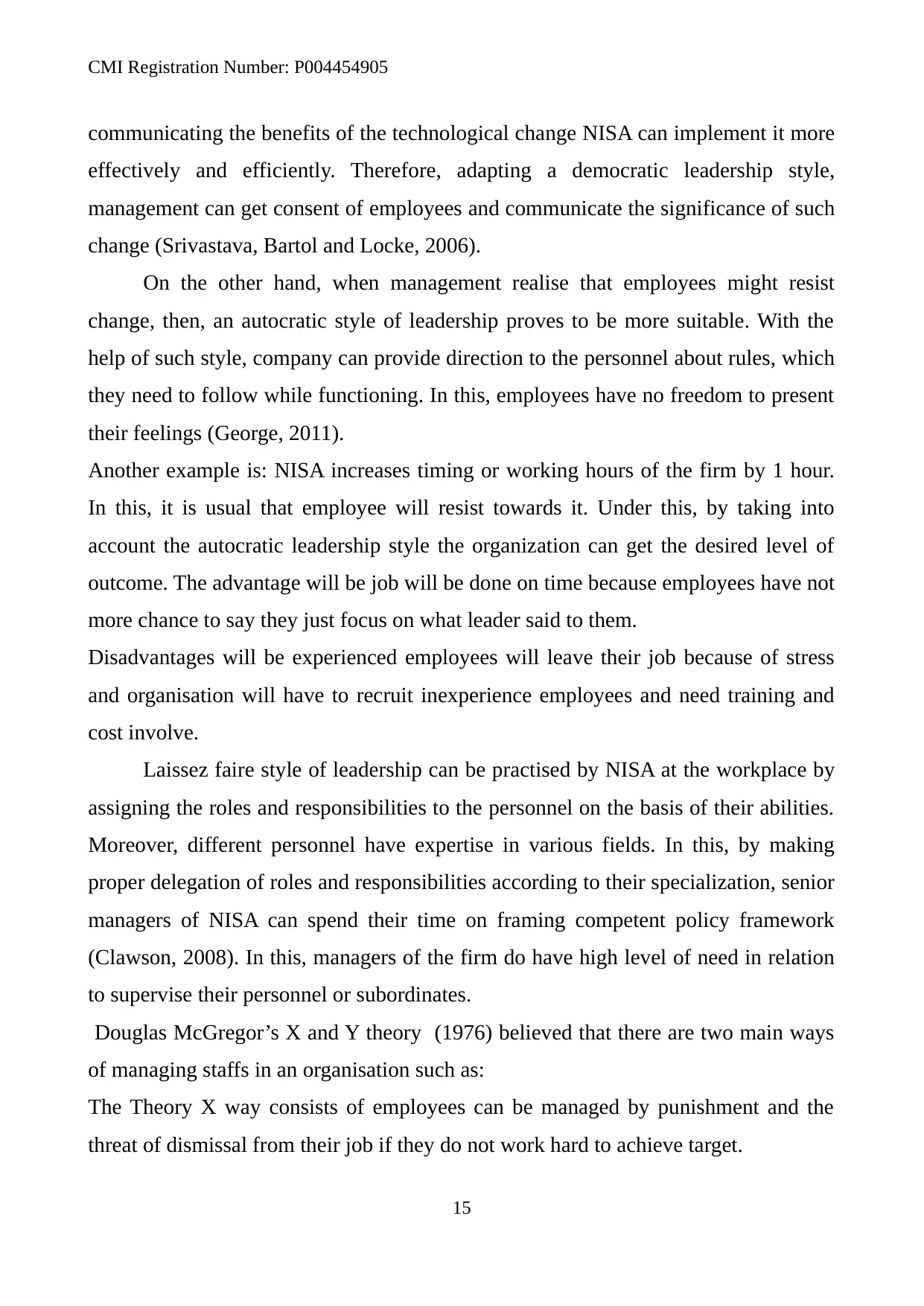
CMI Registration Number: P004454905
communicating the benefits of the technological change NISA can implement it more
effectively and efficiently. Therefore, adapting a democratic leadership style,
management can get consent of employees and communicate the significance of such
change (Srivastava, Bartol and Locke, 2006).
On the other hand, when management realise that employees might resist
change, then, an autocratic style of leadership proves to be more suitable. With the
help of such style, company can provide direction to the personnel about rules, which
they need to follow while functioning. In this, employees have no freedom to present
their feelings (George, 2011).
Another example is: NISA increases timing or working hours of the firm by 1 hour.
In this, it is usual that employee will resist towards it. Under this, by taking into
account the autocratic leadership style the organization can get the desired level of
outcome. The advantage will be job will be done on time because employees have not
more chance to say they just focus on what leader said to them.
Disadvantages will be experienced employees will leave their job because of stress
and organisation will have to recruit inexperience employees and need training and
cost involve.
Laissez faire style of leadership can be practised by NISA at the workplace by
assigning the roles and responsibilities to the personnel on the basis of their abilities.
Moreover, different personnel have expertise in various fields. In this, by making
proper delegation of roles and responsibilities according to their specialization, senior
managers of NISA can spend their time on framing competent policy framework
(Clawson, 2008). In this, managers of the firm do have high level of need in relation
to supervise their personnel or subordinates.
Douglas McGregor’s X and Y theory (1976) believed that there are two main ways
of managing staffs in an organisation such as:
The Theory X way consists of employees can be managed by punishment and the
threat of dismissal from their job if they do not work hard to achieve target.
15
communicating the benefits of the technological change NISA can implement it more
effectively and efficiently. Therefore, adapting a democratic leadership style,
management can get consent of employees and communicate the significance of such
change (Srivastava, Bartol and Locke, 2006).
On the other hand, when management realise that employees might resist
change, then, an autocratic style of leadership proves to be more suitable. With the
help of such style, company can provide direction to the personnel about rules, which
they need to follow while functioning. In this, employees have no freedom to present
their feelings (George, 2011).
Another example is: NISA increases timing or working hours of the firm by 1 hour.
In this, it is usual that employee will resist towards it. Under this, by taking into
account the autocratic leadership style the organization can get the desired level of
outcome. The advantage will be job will be done on time because employees have not
more chance to say they just focus on what leader said to them.
Disadvantages will be experienced employees will leave their job because of stress
and organisation will have to recruit inexperience employees and need training and
cost involve.
Laissez faire style of leadership can be practised by NISA at the workplace by
assigning the roles and responsibilities to the personnel on the basis of their abilities.
Moreover, different personnel have expertise in various fields. In this, by making
proper delegation of roles and responsibilities according to their specialization, senior
managers of NISA can spend their time on framing competent policy framework
(Clawson, 2008). In this, managers of the firm do have high level of need in relation
to supervise their personnel or subordinates.
Douglas McGregor’s X and Y theory (1976) believed that there are two main ways
of managing staffs in an organisation such as:
The Theory X way consists of employees can be managed by punishment and the
threat of dismissal from their job if they do not work hard to achieve target.
15
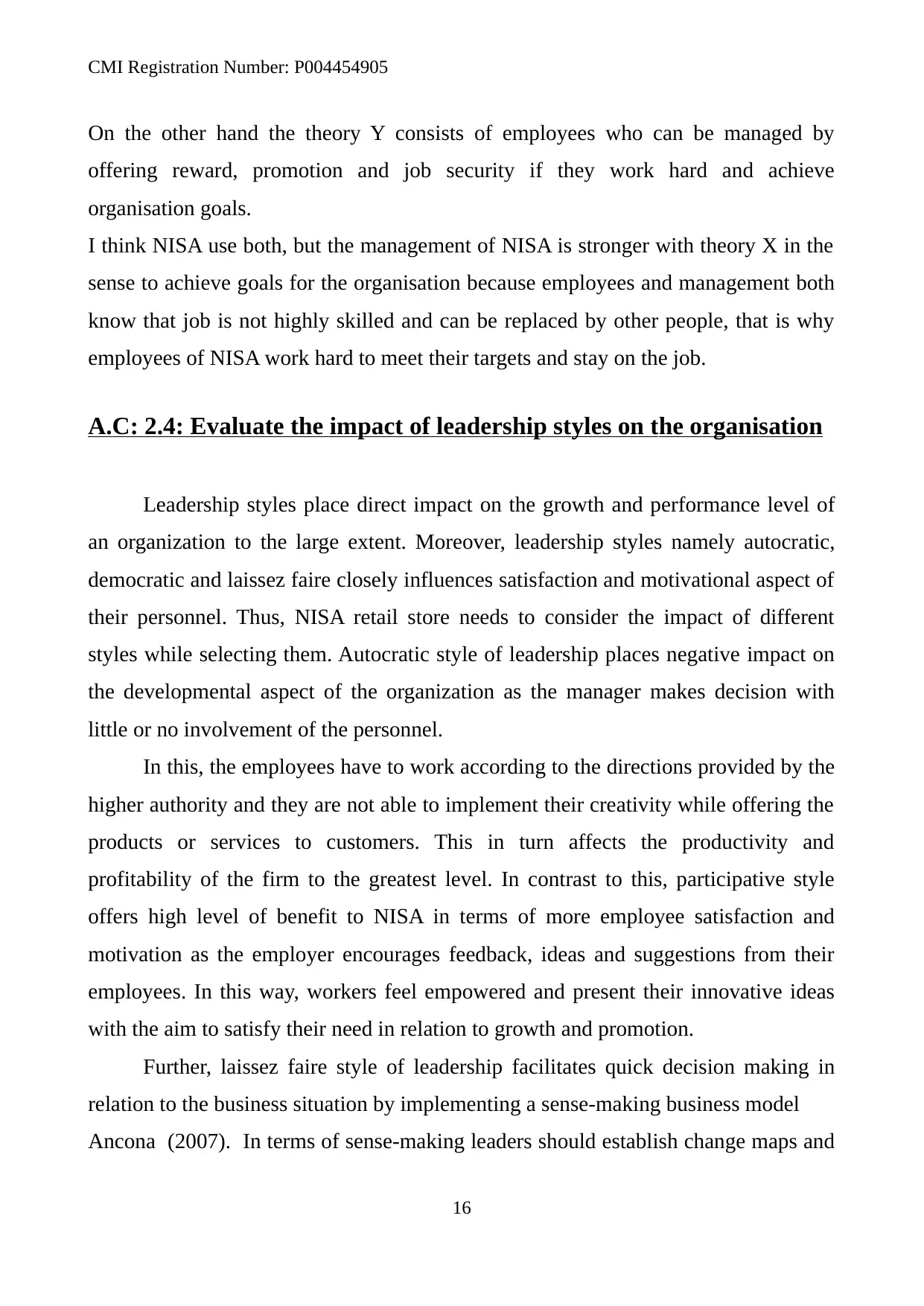
CMI Registration Number: P004454905
On the other hand the theory Y consists of employees who can be managed by
offering reward, promotion and job security if they work hard and achieve
organisation goals.
I think NISA use both, but the management of NISA is stronger with theory X in the
sense to achieve goals for the organisation because employees and management both
know that job is not highly skilled and can be replaced by other people, that is why
employees of NISA work hard to meet their targets and stay on the job.
A.C: 2.4: Evaluate the impact of leadership styles on the organisation
Leadership styles place direct impact on the growth and performance level of
an organization to the large extent. Moreover, leadership styles namely autocratic,
democratic and laissez faire closely influences satisfaction and motivational aspect of
their personnel. Thus, NISA retail store needs to consider the impact of different
styles while selecting them. Autocratic style of leadership places negative impact on
the developmental aspect of the organization as the manager makes decision with
little or no involvement of the personnel.
In this, the employees have to work according to the directions provided by the
higher authority and they are not able to implement their creativity while offering the
products or services to customers. This in turn affects the productivity and
profitability of the firm to the greatest level. In contrast to this, participative style
offers high level of benefit to NISA in terms of more employee satisfaction and
motivation as the employer encourages feedback, ideas and suggestions from their
employees. In this way, workers feel empowered and present their innovative ideas
with the aim to satisfy their need in relation to growth and promotion.
Further, laissez faire style of leadership facilitates quick decision making in
relation to the business situation by implementing a sense-making business model
Ancona (2007). In terms of sense-making leaders should establish change maps and
16
On the other hand the theory Y consists of employees who can be managed by
offering reward, promotion and job security if they work hard and achieve
organisation goals.
I think NISA use both, but the management of NISA is stronger with theory X in the
sense to achieve goals for the organisation because employees and management both
know that job is not highly skilled and can be replaced by other people, that is why
employees of NISA work hard to meet their targets and stay on the job.
A.C: 2.4: Evaluate the impact of leadership styles on the organisation
Leadership styles place direct impact on the growth and performance level of
an organization to the large extent. Moreover, leadership styles namely autocratic,
democratic and laissez faire closely influences satisfaction and motivational aspect of
their personnel. Thus, NISA retail store needs to consider the impact of different
styles while selecting them. Autocratic style of leadership places negative impact on
the developmental aspect of the organization as the manager makes decision with
little or no involvement of the personnel.
In this, the employees have to work according to the directions provided by the
higher authority and they are not able to implement their creativity while offering the
products or services to customers. This in turn affects the productivity and
profitability of the firm to the greatest level. In contrast to this, participative style
offers high level of benefit to NISA in terms of more employee satisfaction and
motivation as the employer encourages feedback, ideas and suggestions from their
employees. In this way, workers feel empowered and present their innovative ideas
with the aim to satisfy their need in relation to growth and promotion.
Further, laissez faire style of leadership facilitates quick decision making in
relation to the business situation by implementing a sense-making business model
Ancona (2007). In terms of sense-making leaders should establish change maps and
16
Secure Best Marks with AI Grader
Need help grading? Try our AI Grader for instant feedback on your assignments.
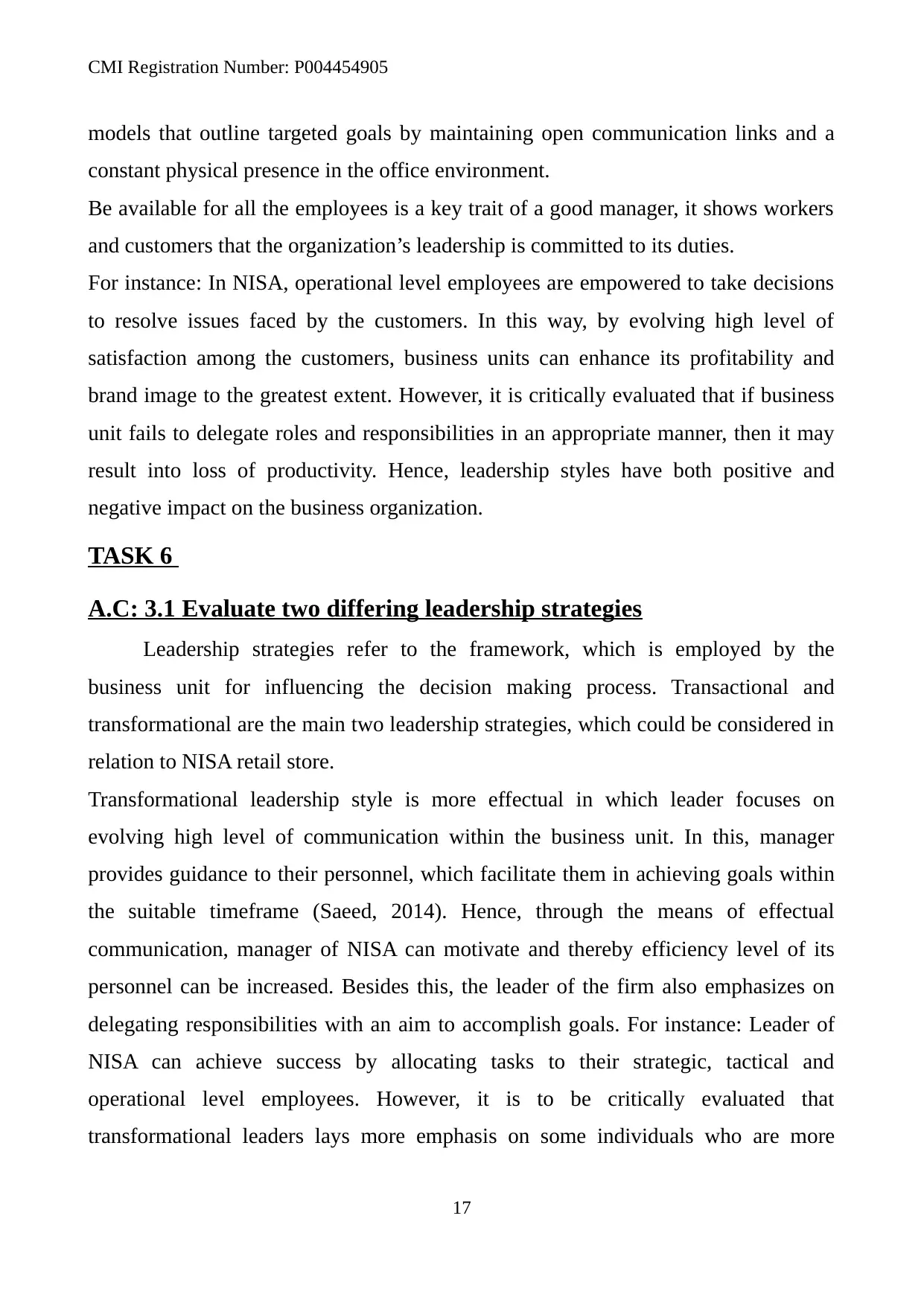
CMI Registration Number: P004454905
models that outline targeted goals by maintaining open communication links and a
constant physical presence in the office environment.
Be available for all the employees is a key trait of a good manager, it shows workers
and customers that the organization’s leadership is committed to its duties.
For instance: In NISA, operational level employees are empowered to take decisions
to resolve issues faced by the customers. In this way, by evolving high level of
satisfaction among the customers, business units can enhance its profitability and
brand image to the greatest extent. However, it is critically evaluated that if business
unit fails to delegate roles and responsibilities in an appropriate manner, then it may
result into loss of productivity. Hence, leadership styles have both positive and
negative impact on the business organization.
TASK 6
A.C: 3.1 Evaluate two differing leadership strategies
Leadership strategies refer to the framework, which is employed by the
business unit for influencing the decision making process. Transactional and
transformational are the main two leadership strategies, which could be considered in
relation to NISA retail store.
Transformational leadership style is more effectual in which leader focuses on
evolving high level of communication within the business unit. In this, manager
provides guidance to their personnel, which facilitate them in achieving goals within
the suitable timeframe (Saeed, 2014). Hence, through the means of effectual
communication, manager of NISA can motivate and thereby efficiency level of its
personnel can be increased. Besides this, the leader of the firm also emphasizes on
delegating responsibilities with an aim to accomplish goals. For instance: Leader of
NISA can achieve success by allocating tasks to their strategic, tactical and
operational level employees. However, it is to be critically evaluated that
transformational leaders lays more emphasis on some individuals who are more
17
models that outline targeted goals by maintaining open communication links and a
constant physical presence in the office environment.
Be available for all the employees is a key trait of a good manager, it shows workers
and customers that the organization’s leadership is committed to its duties.
For instance: In NISA, operational level employees are empowered to take decisions
to resolve issues faced by the customers. In this way, by evolving high level of
satisfaction among the customers, business units can enhance its profitability and
brand image to the greatest extent. However, it is critically evaluated that if business
unit fails to delegate roles and responsibilities in an appropriate manner, then it may
result into loss of productivity. Hence, leadership styles have both positive and
negative impact on the business organization.
TASK 6
A.C: 3.1 Evaluate two differing leadership strategies
Leadership strategies refer to the framework, which is employed by the
business unit for influencing the decision making process. Transactional and
transformational are the main two leadership strategies, which could be considered in
relation to NISA retail store.
Transformational leadership style is more effectual in which leader focuses on
evolving high level of communication within the business unit. In this, manager
provides guidance to their personnel, which facilitate them in achieving goals within
the suitable timeframe (Saeed, 2014). Hence, through the means of effectual
communication, manager of NISA can motivate and thereby efficiency level of its
personnel can be increased. Besides this, the leader of the firm also emphasizes on
delegating responsibilities with an aim to accomplish goals. For instance: Leader of
NISA can achieve success by allocating tasks to their strategic, tactical and
operational level employees. However, it is to be critically evaluated that
transformational leaders lays more emphasis on some individuals who are more
17
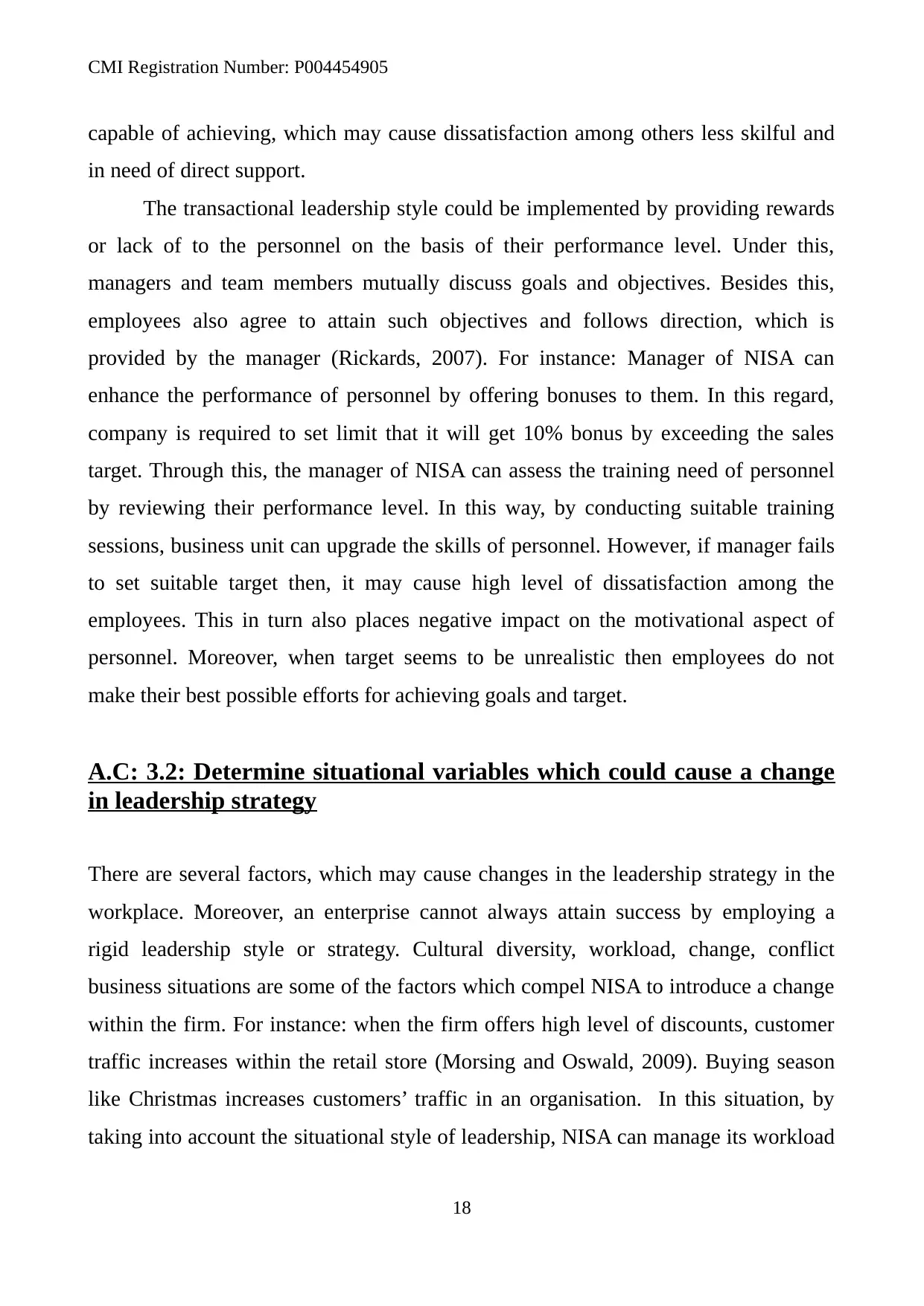
CMI Registration Number: P004454905
capable of achieving, which may cause dissatisfaction among others less skilful and
in need of direct support.
The transactional leadership style could be implemented by providing rewards
or lack of to the personnel on the basis of their performance level. Under this,
managers and team members mutually discuss goals and objectives. Besides this,
employees also agree to attain such objectives and follows direction, which is
provided by the manager (Rickards, 2007). For instance: Manager of NISA can
enhance the performance of personnel by offering bonuses to them. In this regard,
company is required to set limit that it will get 10% bonus by exceeding the sales
target. Through this, the manager of NISA can assess the training need of personnel
by reviewing their performance level. In this way, by conducting suitable training
sessions, business unit can upgrade the skills of personnel. However, if manager fails
to set suitable target then, it may cause high level of dissatisfaction among the
employees. This in turn also places negative impact on the motivational aspect of
personnel. Moreover, when target seems to be unrealistic then employees do not
make their best possible efforts for achieving goals and target.
A.C: 3.2: Determine situational variables which could cause a change
in leadership strategy
There are several factors, which may cause changes in the leadership strategy in the
workplace. Moreover, an enterprise cannot always attain success by employing a
rigid leadership style or strategy. Cultural diversity, workload, change, conflict
business situations are some of the factors which compel NISA to introduce a change
within the firm. For instance: when the firm offers high level of discounts, customer
traffic increases within the retail store (Morsing and Oswald, 2009). Buying season
like Christmas increases customers’ traffic in an organisation. In this situation, by
taking into account the situational style of leadership, NISA can manage its workload
18
capable of achieving, which may cause dissatisfaction among others less skilful and
in need of direct support.
The transactional leadership style could be implemented by providing rewards
or lack of to the personnel on the basis of their performance level. Under this,
managers and team members mutually discuss goals and objectives. Besides this,
employees also agree to attain such objectives and follows direction, which is
provided by the manager (Rickards, 2007). For instance: Manager of NISA can
enhance the performance of personnel by offering bonuses to them. In this regard,
company is required to set limit that it will get 10% bonus by exceeding the sales
target. Through this, the manager of NISA can assess the training need of personnel
by reviewing their performance level. In this way, by conducting suitable training
sessions, business unit can upgrade the skills of personnel. However, if manager fails
to set suitable target then, it may cause high level of dissatisfaction among the
employees. This in turn also places negative impact on the motivational aspect of
personnel. Moreover, when target seems to be unrealistic then employees do not
make their best possible efforts for achieving goals and target.
A.C: 3.2: Determine situational variables which could cause a change
in leadership strategy
There are several factors, which may cause changes in the leadership strategy in the
workplace. Moreover, an enterprise cannot always attain success by employing a
rigid leadership style or strategy. Cultural diversity, workload, change, conflict
business situations are some of the factors which compel NISA to introduce a change
within the firm. For instance: when the firm offers high level of discounts, customer
traffic increases within the retail store (Morsing and Oswald, 2009). Buying season
like Christmas increases customers’ traffic in an organisation. In this situation, by
taking into account the situational style of leadership, NISA can manage its workload
18
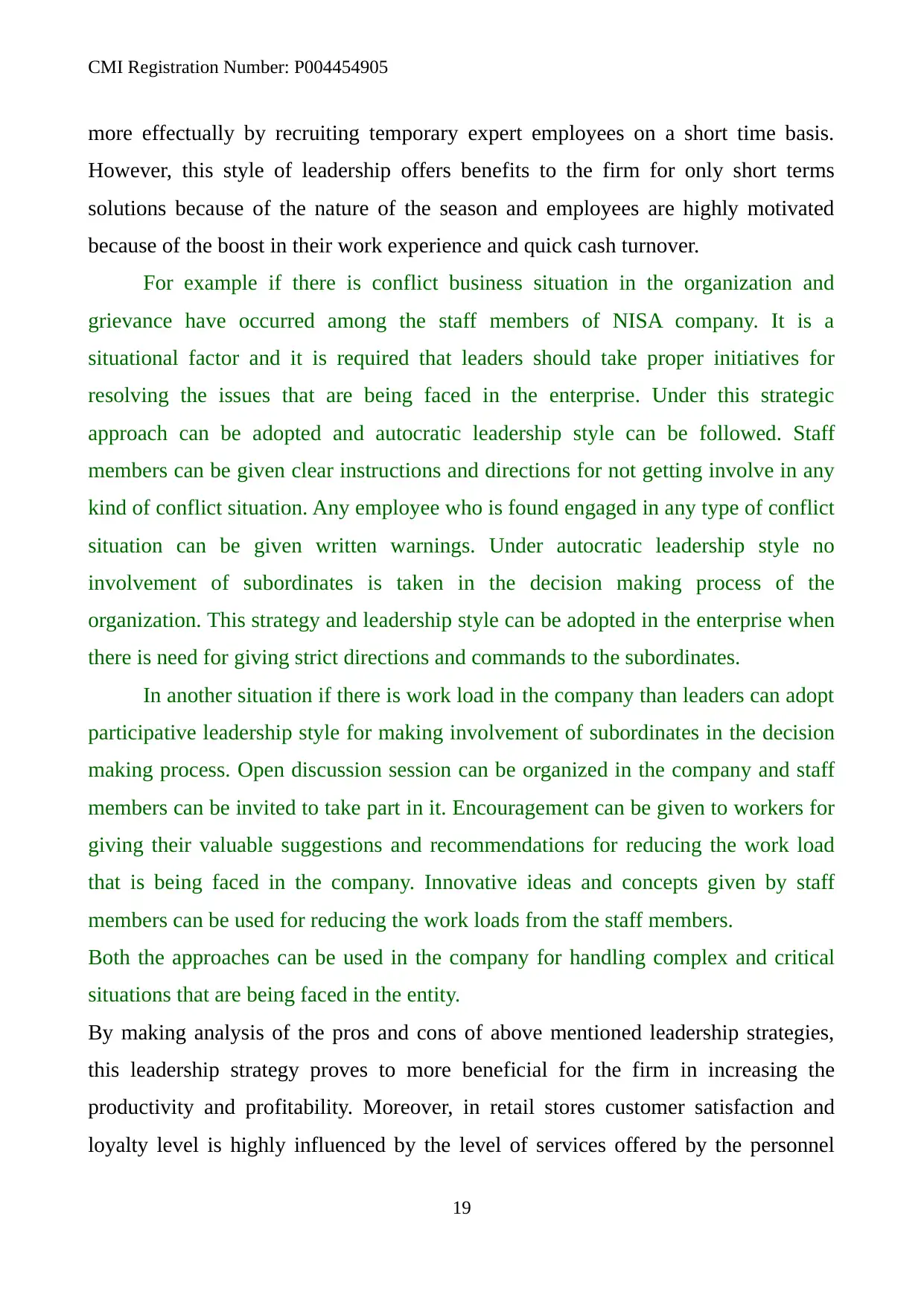
CMI Registration Number: P004454905
more effectually by recruiting temporary expert employees on a short time basis.
However, this style of leadership offers benefits to the firm for only short terms
solutions because of the nature of the season and employees are highly motivated
because of the boost in their work experience and quick cash turnover.
For example if there is conflict business situation in the organization and
grievance have occurred among the staff members of NISA company. It is a
situational factor and it is required that leaders should take proper initiatives for
resolving the issues that are being faced in the enterprise. Under this strategic
approach can be adopted and autocratic leadership style can be followed. Staff
members can be given clear instructions and directions for not getting involve in any
kind of conflict situation. Any employee who is found engaged in any type of conflict
situation can be given written warnings. Under autocratic leadership style no
involvement of subordinates is taken in the decision making process of the
organization. This strategy and leadership style can be adopted in the enterprise when
there is need for giving strict directions and commands to the subordinates.
In another situation if there is work load in the company than leaders can adopt
participative leadership style for making involvement of subordinates in the decision
making process. Open discussion session can be organized in the company and staff
members can be invited to take part in it. Encouragement can be given to workers for
giving their valuable suggestions and recommendations for reducing the work load
that is being faced in the company. Innovative ideas and concepts given by staff
members can be used for reducing the work loads from the staff members.
Both the approaches can be used in the company for handling complex and critical
situations that are being faced in the entity.
By making analysis of the pros and cons of above mentioned leadership strategies,
this leadership strategy proves to more beneficial for the firm in increasing the
productivity and profitability. Moreover, in retail stores customer satisfaction and
loyalty level is highly influenced by the level of services offered by the personnel
19
more effectually by recruiting temporary expert employees on a short time basis.
However, this style of leadership offers benefits to the firm for only short terms
solutions because of the nature of the season and employees are highly motivated
because of the boost in their work experience and quick cash turnover.
For example if there is conflict business situation in the organization and
grievance have occurred among the staff members of NISA company. It is a
situational factor and it is required that leaders should take proper initiatives for
resolving the issues that are being faced in the enterprise. Under this strategic
approach can be adopted and autocratic leadership style can be followed. Staff
members can be given clear instructions and directions for not getting involve in any
kind of conflict situation. Any employee who is found engaged in any type of conflict
situation can be given written warnings. Under autocratic leadership style no
involvement of subordinates is taken in the decision making process of the
organization. This strategy and leadership style can be adopted in the enterprise when
there is need for giving strict directions and commands to the subordinates.
In another situation if there is work load in the company than leaders can adopt
participative leadership style for making involvement of subordinates in the decision
making process. Open discussion session can be organized in the company and staff
members can be invited to take part in it. Encouragement can be given to workers for
giving their valuable suggestions and recommendations for reducing the work load
that is being faced in the company. Innovative ideas and concepts given by staff
members can be used for reducing the work loads from the staff members.
Both the approaches can be used in the company for handling complex and critical
situations that are being faced in the entity.
By making analysis of the pros and cons of above mentioned leadership strategies,
this leadership strategy proves to more beneficial for the firm in increasing the
productivity and profitability. Moreover, in retail stores customer satisfaction and
loyalty level is highly influenced by the level of services offered by the personnel
19
Paraphrase This Document
Need a fresh take? Get an instant paraphrase of this document with our AI Paraphraser
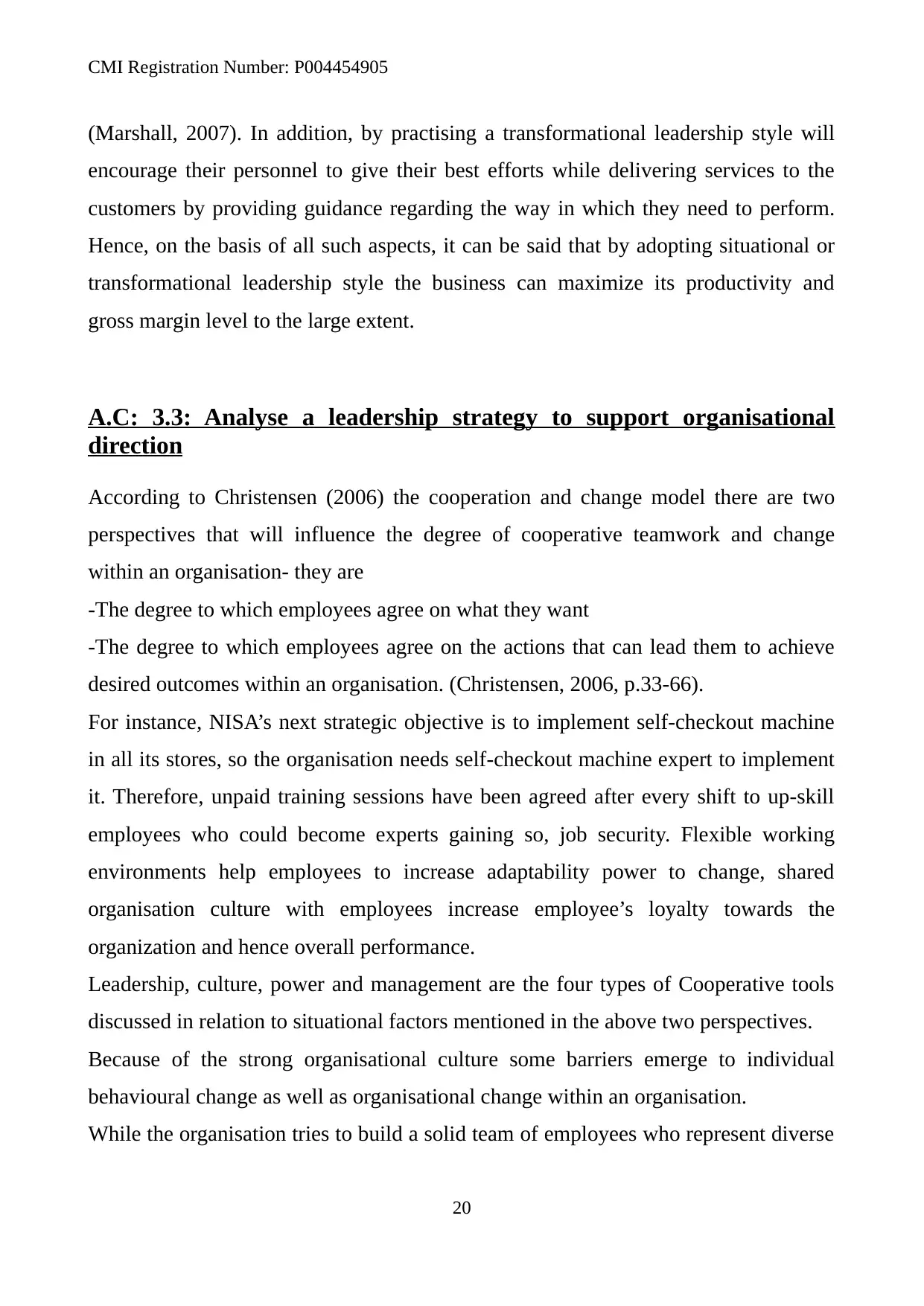
CMI Registration Number: P004454905
(Marshall, 2007). In addition, by practising a transformational leadership style will
encourage their personnel to give their best efforts while delivering services to the
customers by providing guidance regarding the way in which they need to perform.
Hence, on the basis of all such aspects, it can be said that by adopting situational or
transformational leadership style the business can maximize its productivity and
gross margin level to the large extent.
A.C: 3.3: Analyse a leadership strategy to support organisational
direction
According to Christensen (2006) the cooperation and change model there are two
perspectives that will influence the degree of cooperative teamwork and change
within an organisation- they are
-The degree to which employees agree on what they want
-The degree to which employees agree on the actions that can lead them to achieve
desired outcomes within an organisation. (Christensen, 2006, p.33-66).
For instance, NISA’s next strategic objective is to implement self-checkout machine
in all its stores, so the organisation needs self-checkout machine expert to implement
it. Therefore, unpaid training sessions have been agreed after every shift to up-skill
employees who could become experts gaining so, job security. Flexible working
environments help employees to increase adaptability power to change, shared
organisation culture with employees increase employee’s loyalty towards the
organization and hence overall performance.
Leadership, culture, power and management are the four types of Cooperative tools
discussed in relation to situational factors mentioned in the above two perspectives.
Because of the strong organisational culture some barriers emerge to individual
behavioural change as well as organisational change within an organisation.
While the organisation tries to build a solid team of employees who represent diverse
20
(Marshall, 2007). In addition, by practising a transformational leadership style will
encourage their personnel to give their best efforts while delivering services to the
customers by providing guidance regarding the way in which they need to perform.
Hence, on the basis of all such aspects, it can be said that by adopting situational or
transformational leadership style the business can maximize its productivity and
gross margin level to the large extent.
A.C: 3.3: Analyse a leadership strategy to support organisational
direction
According to Christensen (2006) the cooperation and change model there are two
perspectives that will influence the degree of cooperative teamwork and change
within an organisation- they are
-The degree to which employees agree on what they want
-The degree to which employees agree on the actions that can lead them to achieve
desired outcomes within an organisation. (Christensen, 2006, p.33-66).
For instance, NISA’s next strategic objective is to implement self-checkout machine
in all its stores, so the organisation needs self-checkout machine expert to implement
it. Therefore, unpaid training sessions have been agreed after every shift to up-skill
employees who could become experts gaining so, job security. Flexible working
environments help employees to increase adaptability power to change, shared
organisation culture with employees increase employee’s loyalty towards the
organization and hence overall performance.
Leadership, culture, power and management are the four types of Cooperative tools
discussed in relation to situational factors mentioned in the above two perspectives.
Because of the strong organisational culture some barriers emerge to individual
behavioural change as well as organisational change within an organisation.
While the organisation tries to build a solid team of employees who represent diverse
20
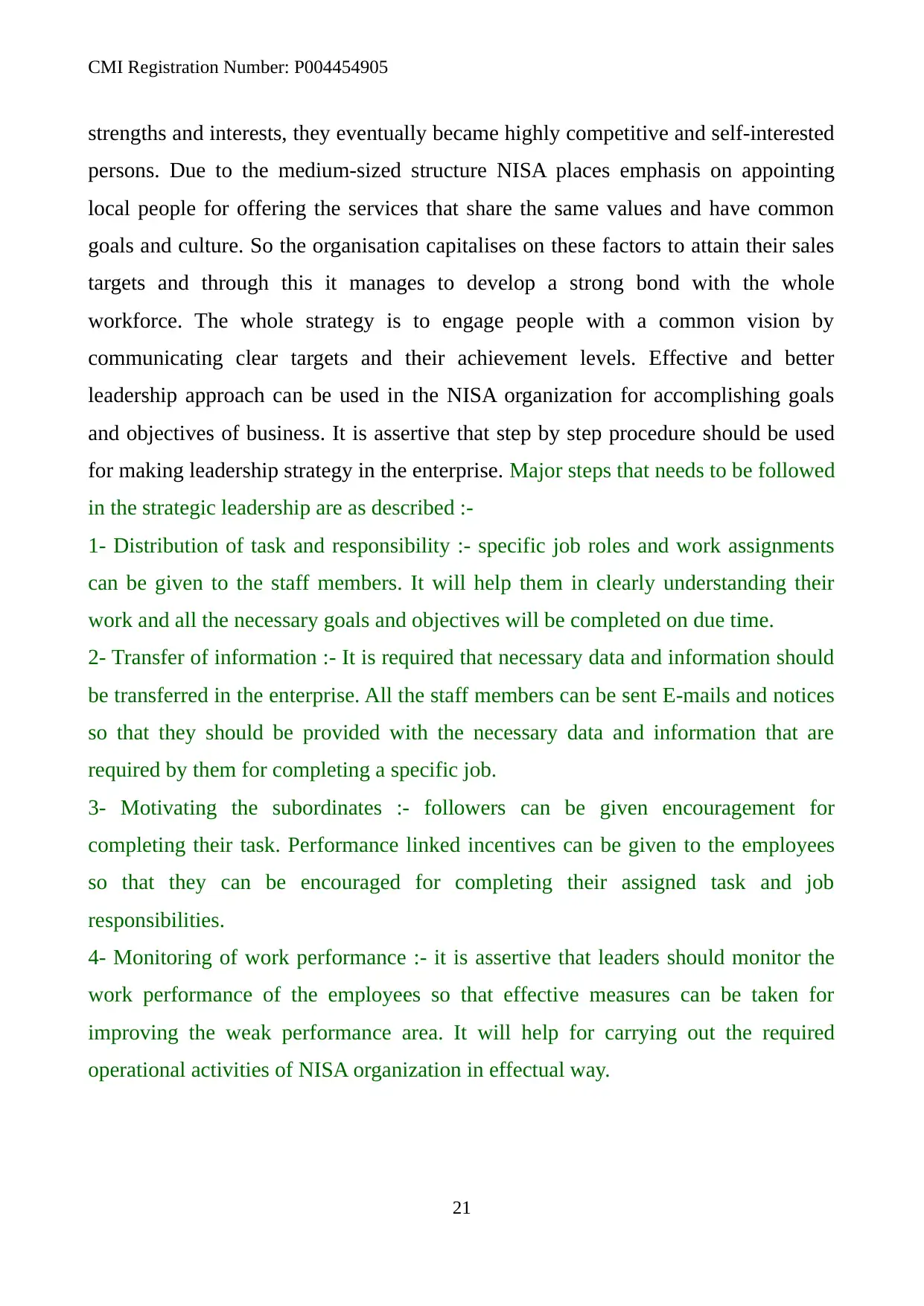
CMI Registration Number: P004454905
strengths and interests, they eventually became highly competitive and self-interested
persons. Due to the medium-sized structure NISA places emphasis on appointing
local people for offering the services that share the same values and have common
goals and culture. So the organisation capitalises on these factors to attain their sales
targets and through this it manages to develop a strong bond with the whole
workforce. The whole strategy is to engage people with a common vision by
communicating clear targets and their achievement levels. Effective and better
leadership approach can be used in the NISA organization for accomplishing goals
and objectives of business. It is assertive that step by step procedure should be used
for making leadership strategy in the enterprise. Major steps that needs to be followed
in the strategic leadership are as described :-
1- Distribution of task and responsibility :- specific job roles and work assignments
can be given to the staff members. It will help them in clearly understanding their
work and all the necessary goals and objectives will be completed on due time.
2- Transfer of information :- It is required that necessary data and information should
be transferred in the enterprise. All the staff members can be sent E-mails and notices
so that they should be provided with the necessary data and information that are
required by them for completing a specific job.
3- Motivating the subordinates :- followers can be given encouragement for
completing their task. Performance linked incentives can be given to the employees
so that they can be encouraged for completing their assigned task and job
responsibilities.
4- Monitoring of work performance :- it is assertive that leaders should monitor the
work performance of the employees so that effective measures can be taken for
improving the weak performance area. It will help for carrying out the required
operational activities of NISA organization in effectual way.
21
strengths and interests, they eventually became highly competitive and self-interested
persons. Due to the medium-sized structure NISA places emphasis on appointing
local people for offering the services that share the same values and have common
goals and culture. So the organisation capitalises on these factors to attain their sales
targets and through this it manages to develop a strong bond with the whole
workforce. The whole strategy is to engage people with a common vision by
communicating clear targets and their achievement levels. Effective and better
leadership approach can be used in the NISA organization for accomplishing goals
and objectives of business. It is assertive that step by step procedure should be used
for making leadership strategy in the enterprise. Major steps that needs to be followed
in the strategic leadership are as described :-
1- Distribution of task and responsibility :- specific job roles and work assignments
can be given to the staff members. It will help them in clearly understanding their
work and all the necessary goals and objectives will be completed on due time.
2- Transfer of information :- It is required that necessary data and information should
be transferred in the enterprise. All the staff members can be sent E-mails and notices
so that they should be provided with the necessary data and information that are
required by them for completing a specific job.
3- Motivating the subordinates :- followers can be given encouragement for
completing their task. Performance linked incentives can be given to the employees
so that they can be encouraged for completing their assigned task and job
responsibilities.
4- Monitoring of work performance :- it is assertive that leaders should monitor the
work performance of the employees so that effective measures can be taken for
improving the weak performance area. It will help for carrying out the required
operational activities of NISA organization in effectual way.
21
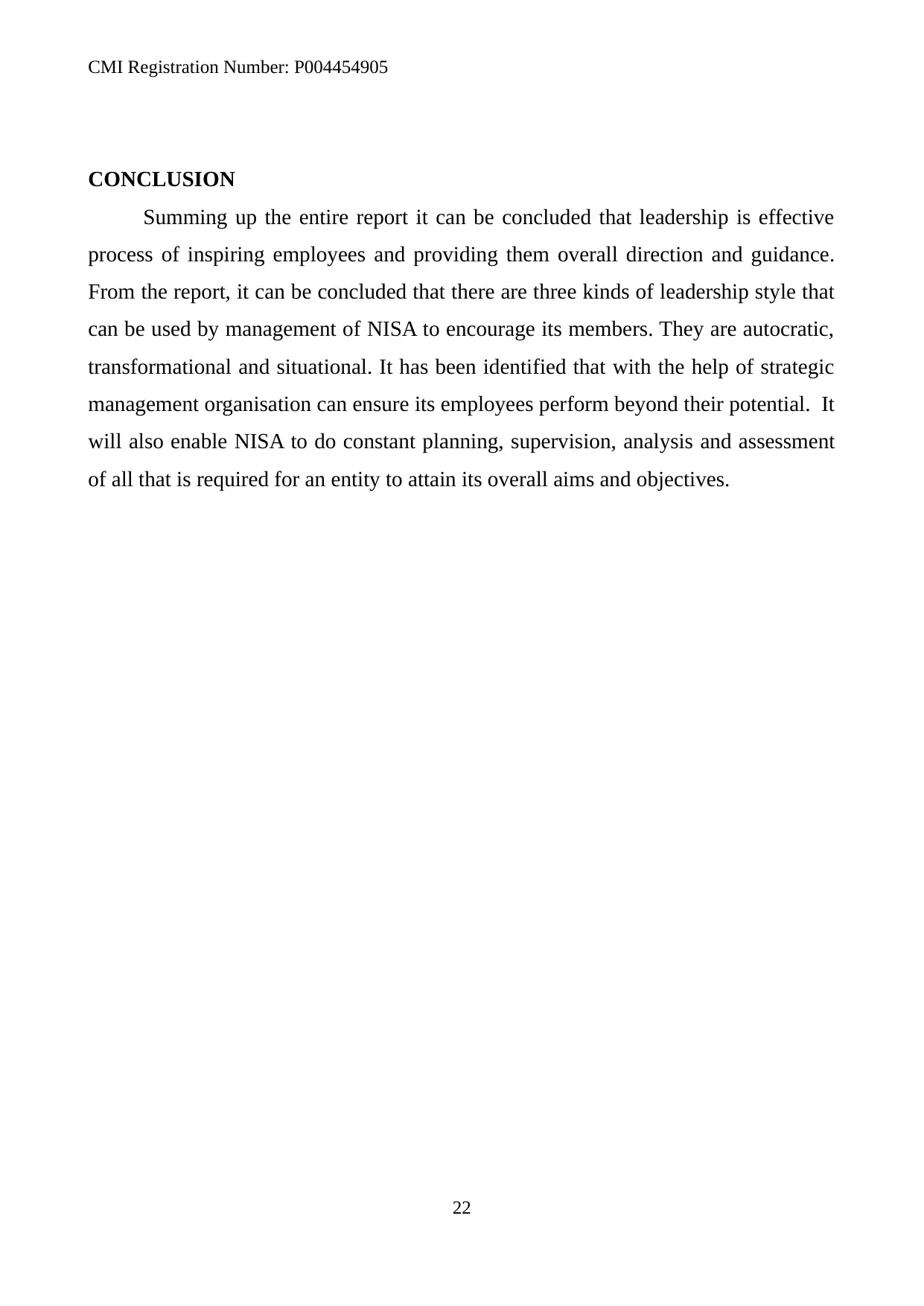
CMI Registration Number: P004454905
CONCLUSION
Summing up the entire report it can be concluded that leadership is effective
process of inspiring employees and providing them overall direction and guidance.
From the report, it can be concluded that there are three kinds of leadership style that
can be used by management of NISA to encourage its members. They are autocratic,
transformational and situational. It has been identified that with the help of strategic
management organisation can ensure its employees perform beyond their potential. It
will also enable NISA to do constant planning, supervision, analysis and assessment
of all that is required for an entity to attain its overall aims and objectives.
22
CONCLUSION
Summing up the entire report it can be concluded that leadership is effective
process of inspiring employees and providing them overall direction and guidance.
From the report, it can be concluded that there are three kinds of leadership style that
can be used by management of NISA to encourage its members. They are autocratic,
transformational and situational. It has been identified that with the help of strategic
management organisation can ensure its employees perform beyond their potential. It
will also enable NISA to do constant planning, supervision, analysis and assessment
of all that is required for an entity to attain its overall aims and objectives.
22
Secure Best Marks with AI Grader
Need help grading? Try our AI Grader for instant feedback on your assignments.
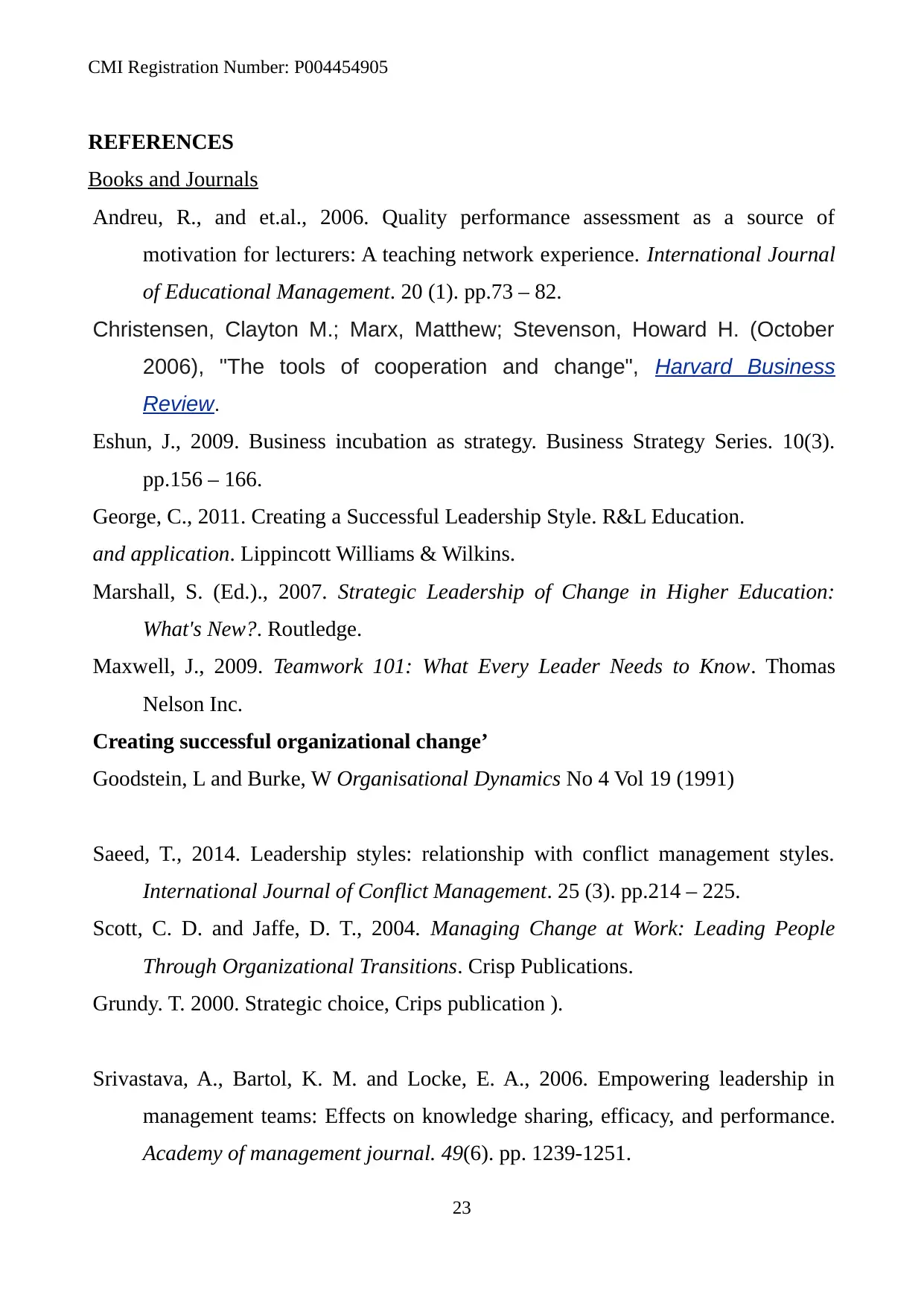
CMI Registration Number: P004454905
REFERENCES
Books and Journals
Andreu, R., and et.al., 2006. Quality performance assessment as a source of
motivation for lecturers: A teaching network experience. International Journal
of Educational Management. 20 (1). pp.73 – 82.
Christensen, Clayton M.; Marx, Matthew; Stevenson, Howard H. (October
2006), "The tools of cooperation and change", Harvard Business
Review.
Eshun, J., 2009. Business incubation as strategy. Business Strategy Series. 10(3).
pp.156 – 166.
George, C., 2011. Creating a Successful Leadership Style. R&L Education.
and application. Lippincott Williams & Wilkins.
Marshall, S. (Ed.)., 2007. Strategic Leadership of Change in Higher Education:
What's New?. Routledge.
Maxwell, J., 2009. Teamwork 101: What Every Leader Needs to Know. Thomas
Nelson Inc.
Creating successful organizational change’
Goodstein, L and Burke, W Organisational Dynamics No 4 Vol 19 (1991)
Saeed, T., 2014. Leadership styles: relationship with conflict management styles.
International Journal of Conflict Management. 25 (3). pp.214 – 225.
Scott, C. D. and Jaffe, D. T., 2004. Managing Change at Work: Leading People
Through Organizational Transitions. Crisp Publications.
Grundy. T. 2000. Strategic choice, Crips publication ).
Srivastava, A., Bartol, K. M. and Locke, E. A., 2006. Empowering leadership in
management teams: Effects on knowledge sharing, efficacy, and performance.
Academy of management journal. 49(6). pp. 1239-1251.
23
REFERENCES
Books and Journals
Andreu, R., and et.al., 2006. Quality performance assessment as a source of
motivation for lecturers: A teaching network experience. International Journal
of Educational Management. 20 (1). pp.73 – 82.
Christensen, Clayton M.; Marx, Matthew; Stevenson, Howard H. (October
2006), "The tools of cooperation and change", Harvard Business
Review.
Eshun, J., 2009. Business incubation as strategy. Business Strategy Series. 10(3).
pp.156 – 166.
George, C., 2011. Creating a Successful Leadership Style. R&L Education.
and application. Lippincott Williams & Wilkins.
Marshall, S. (Ed.)., 2007. Strategic Leadership of Change in Higher Education:
What's New?. Routledge.
Maxwell, J., 2009. Teamwork 101: What Every Leader Needs to Know. Thomas
Nelson Inc.
Creating successful organizational change’
Goodstein, L and Burke, W Organisational Dynamics No 4 Vol 19 (1991)
Saeed, T., 2014. Leadership styles: relationship with conflict management styles.
International Journal of Conflict Management. 25 (3). pp.214 – 225.
Scott, C. D. and Jaffe, D. T., 2004. Managing Change at Work: Leading People
Through Organizational Transitions. Crisp Publications.
Grundy. T. 2000. Strategic choice, Crips publication ).
Srivastava, A., Bartol, K. M. and Locke, E. A., 2006. Empowering leadership in
management teams: Effects on knowledge sharing, efficacy, and performance.
Academy of management journal. 49(6). pp. 1239-1251.
23
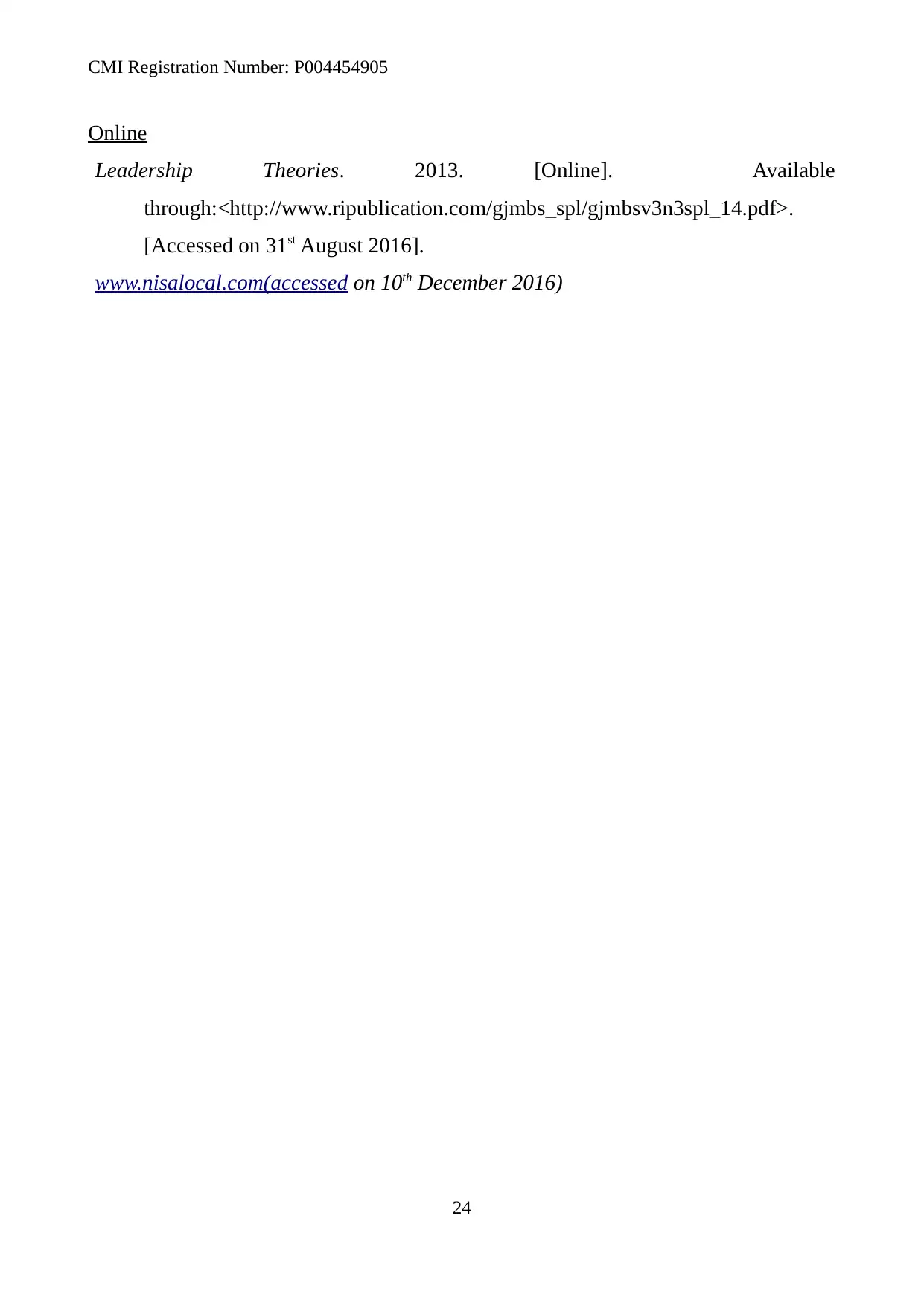
CMI Registration Number: P004454905
Online
Leadership Theories. 2013. [Online]. Available
through:<http://www.ripublication.com/gjmbs_spl/gjmbsv3n3spl_14.pdf>.
[Accessed on 31st August 2016].
www.nisalocal.com(accessed on 10th December 2016)
24
Online
Leadership Theories. 2013. [Online]. Available
through:<http://www.ripublication.com/gjmbs_spl/gjmbsv3n3spl_14.pdf>.
[Accessed on 31st August 2016].
www.nisalocal.com(accessed on 10th December 2016)
24
1 out of 24
Related Documents
Your All-in-One AI-Powered Toolkit for Academic Success.
+13062052269
info@desklib.com
Available 24*7 on WhatsApp / Email
![[object Object]](/_next/static/media/star-bottom.7253800d.svg)
Unlock your academic potential
© 2024 | Zucol Services PVT LTD | All rights reserved.





